Create a new project
Quick walk-through on how to create a new project in Digital Blue Foam. In this section you will be walk-through 12 steps that will teach you the fundamental basics of DBF by setting up a project from scratch.
1. Dashboard
In your account Dashboard you can manage all your projects. You can create new projects, delete projects and share projects with your team. In this page you will find resources such as tutorials, access to help and more!
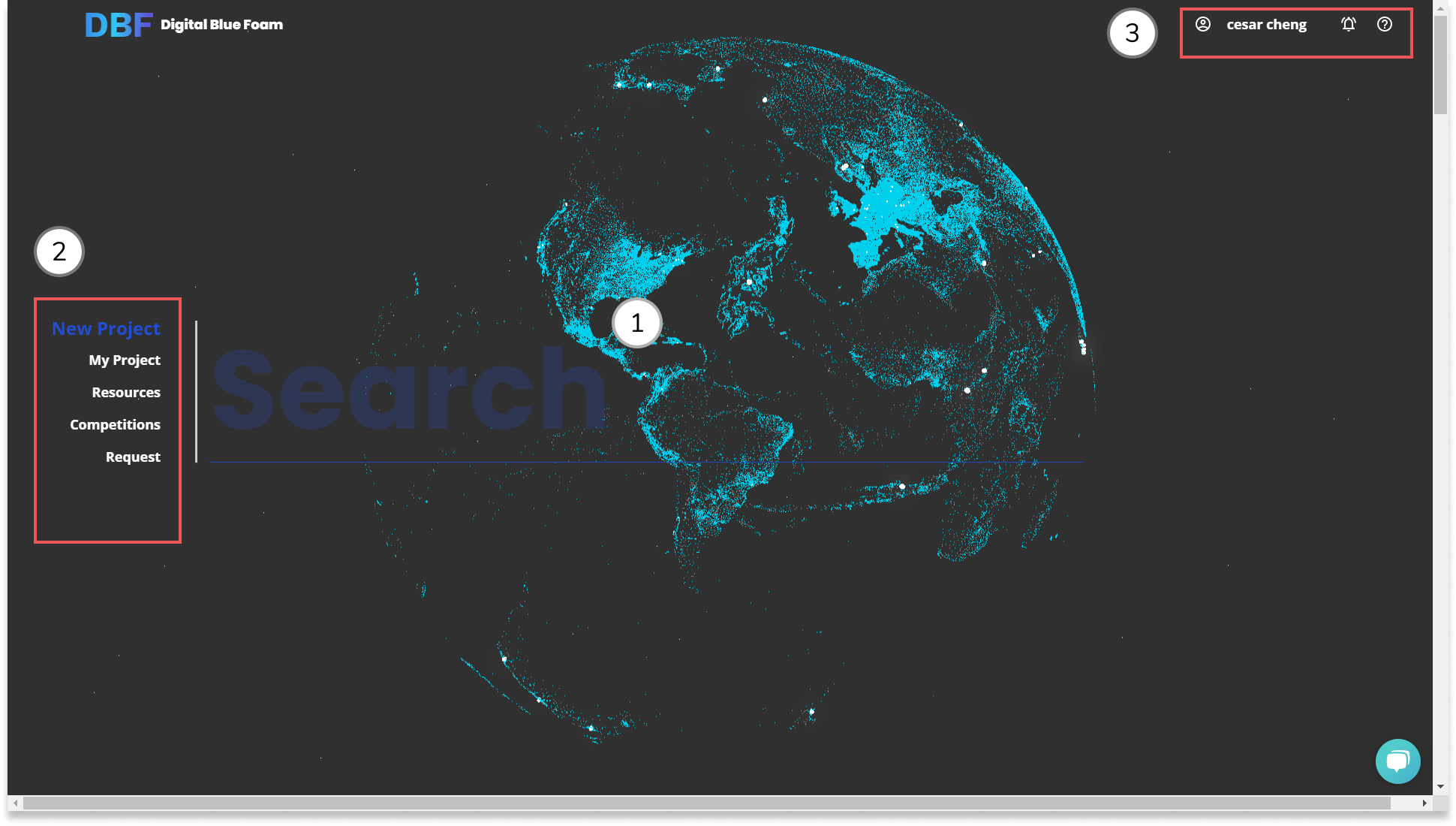
1. Create a new project: Type your project location!
Creating a new project in DBF is simple and easy, all you need to do is type in the search bar the location of your project. For example: New York, USA. You will be taken to a map page of the city where your project is located where you can find and mark your developement site.

2. Navigation
On the Left side you will find a the page navigation with the main sections of your dashboard:
- My projects
- Resources
- Competitions
- Feature Requests
3. My Account
On the top right corner you will find your account settings panel, notifications and help.
My Projects
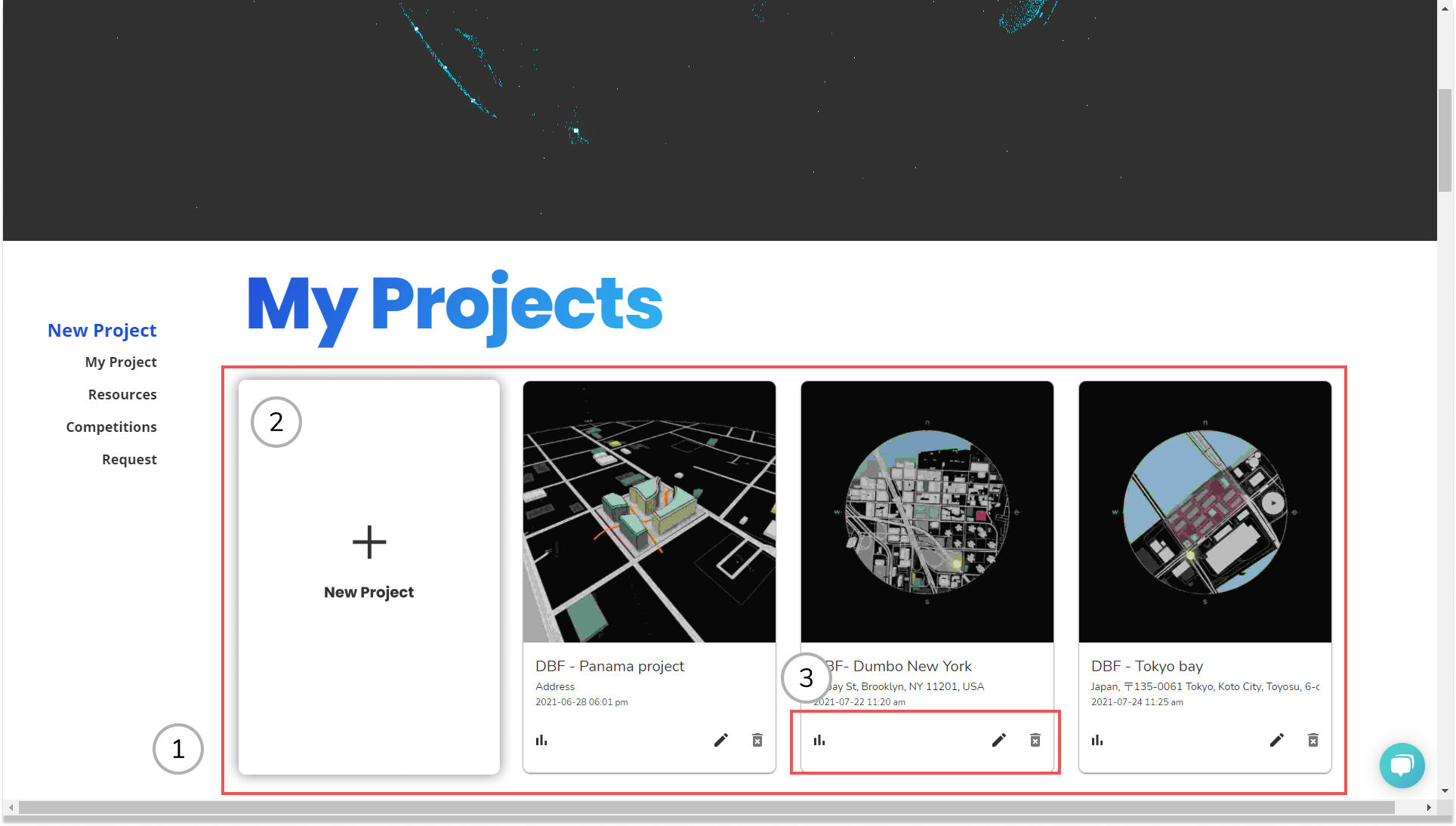
1. My Projects
In this section you will find your saved projects. To access your saved projects simply click on the project you would like to open and you will be taken to the selected project.
2. Create a new project
You can also create a new project by clicking on the + button, you will be asked to type in the project location so ou can continue to the map page where you can find and mark your development site.
3. Manage saved projects
At the bottom of each project card you will find additional options to share your project, view compare page, edit project name and delete project.
Delete a project
Click on the trash button to permanently delete a project.
2. Map page
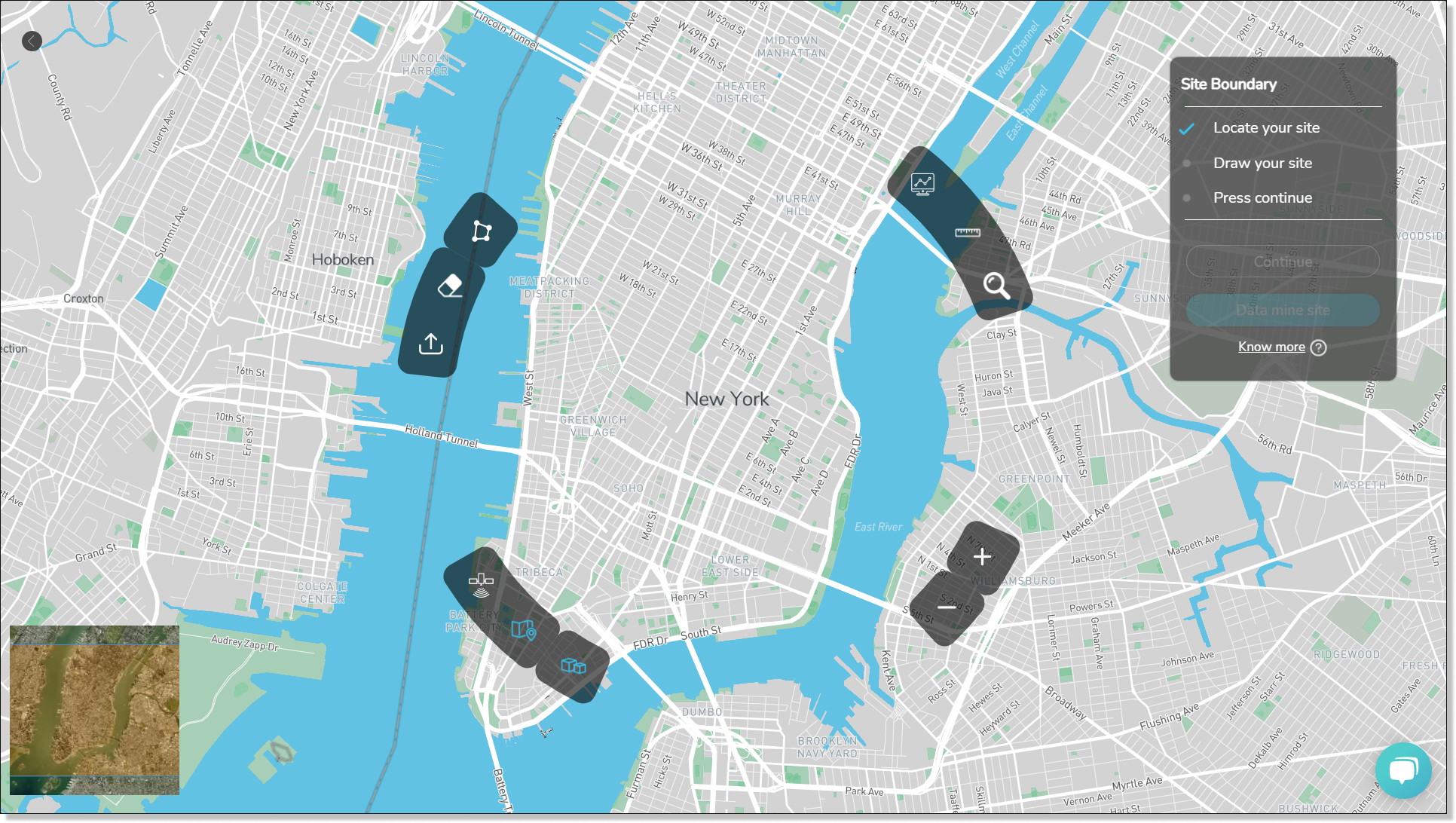
When you input a location you will be taken to a map page of the area that you searched for earlier. To start a project in DBF, you first need to locate your site in the map. Then you need to mark your site and finally confirm your site boundary by clicking on the continue button. DBF will automatically fetch geo-data from relevant sources and get your site ready for you to start working on your project.
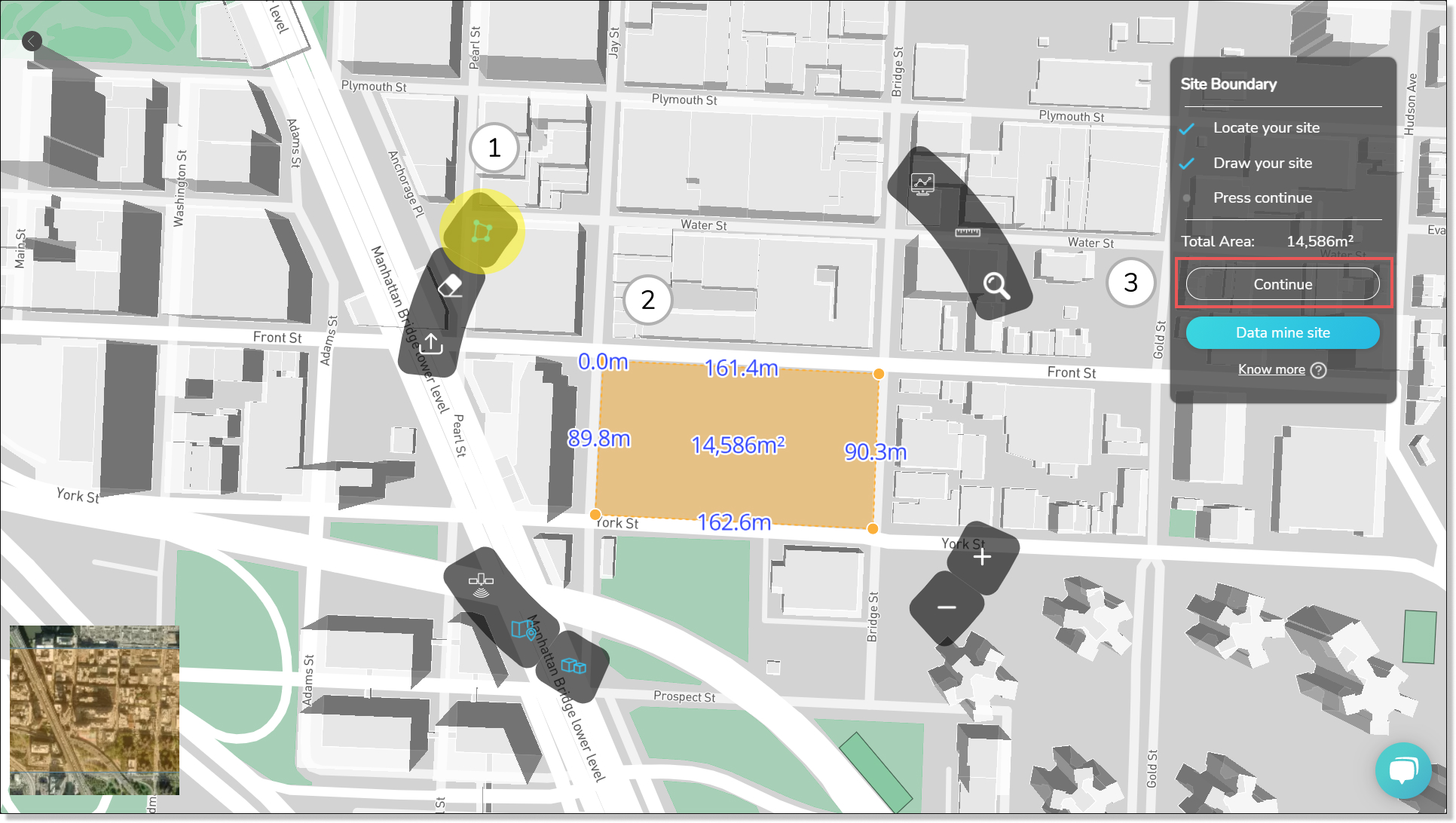
1. Mark your site
Use the draw polygon tool to mark your site. Activate the polygon draw your site's boundary on top of the map. As you draw your site, you will have a display of the site are in the middle of your polygon. Once you have defined your site boundary double click to close your polygon.
If you would like to delete your polygon and start all over again, select your site boundary and click on the eraser button located below the draw polygon tool in the ribbon menu.
2. Edit site boundary
You can edit the boundary of your site by dragging and adjusting the polygon nodes. You can add additional nodes by clicking and draggin the point at the middle of a polygon segment.
3. Confirm site boudary
Once you have defined your site boundary you can check the area of your site on the right side panel and click on the continue button to preceed.
Data-mine Site Context (optional)
Before you continue to DBF design tool, you are given the option to mine the site for urban context data such as:
- Max Height from your context
- Site Coverage from your context
- Number of Subplots (average size of building plot) from your context
- FAR from your context
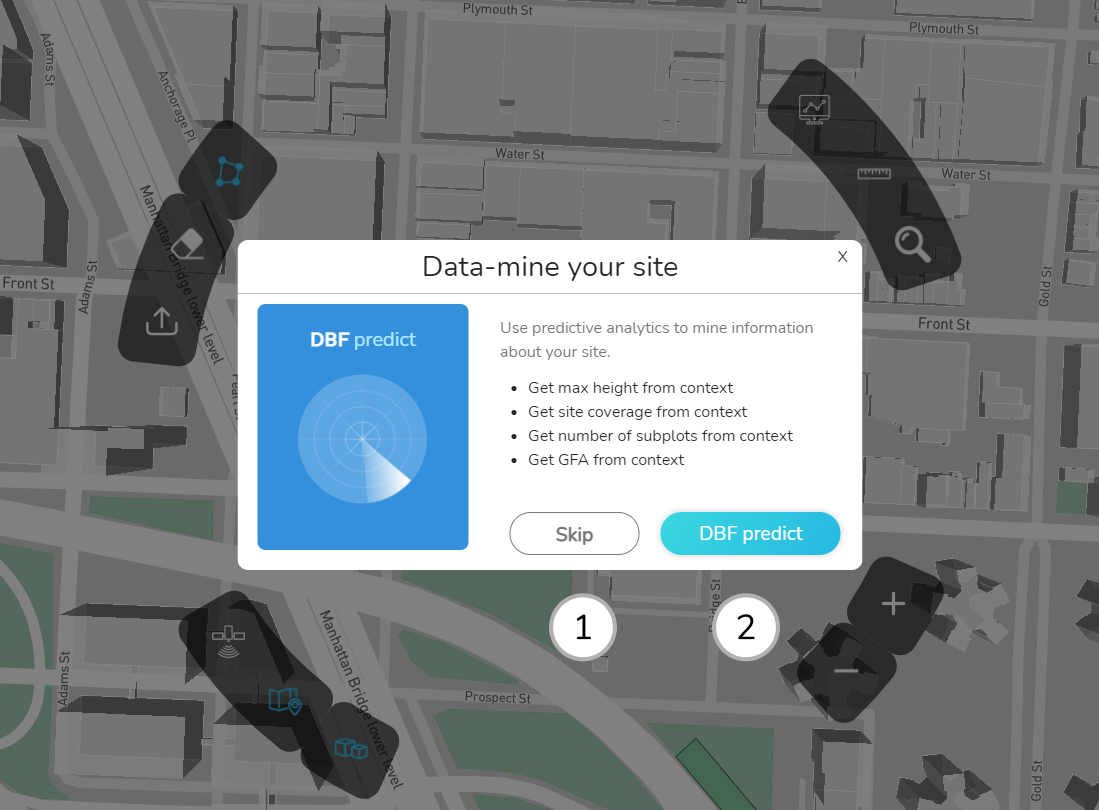
- If you want to continue directly to DBF design tool, click on Continue
- If you want DBF to mine the site for urban context information, click on Data mine site
You can find more information about DBF Predict in the Features section on this topic.
3. Navigate
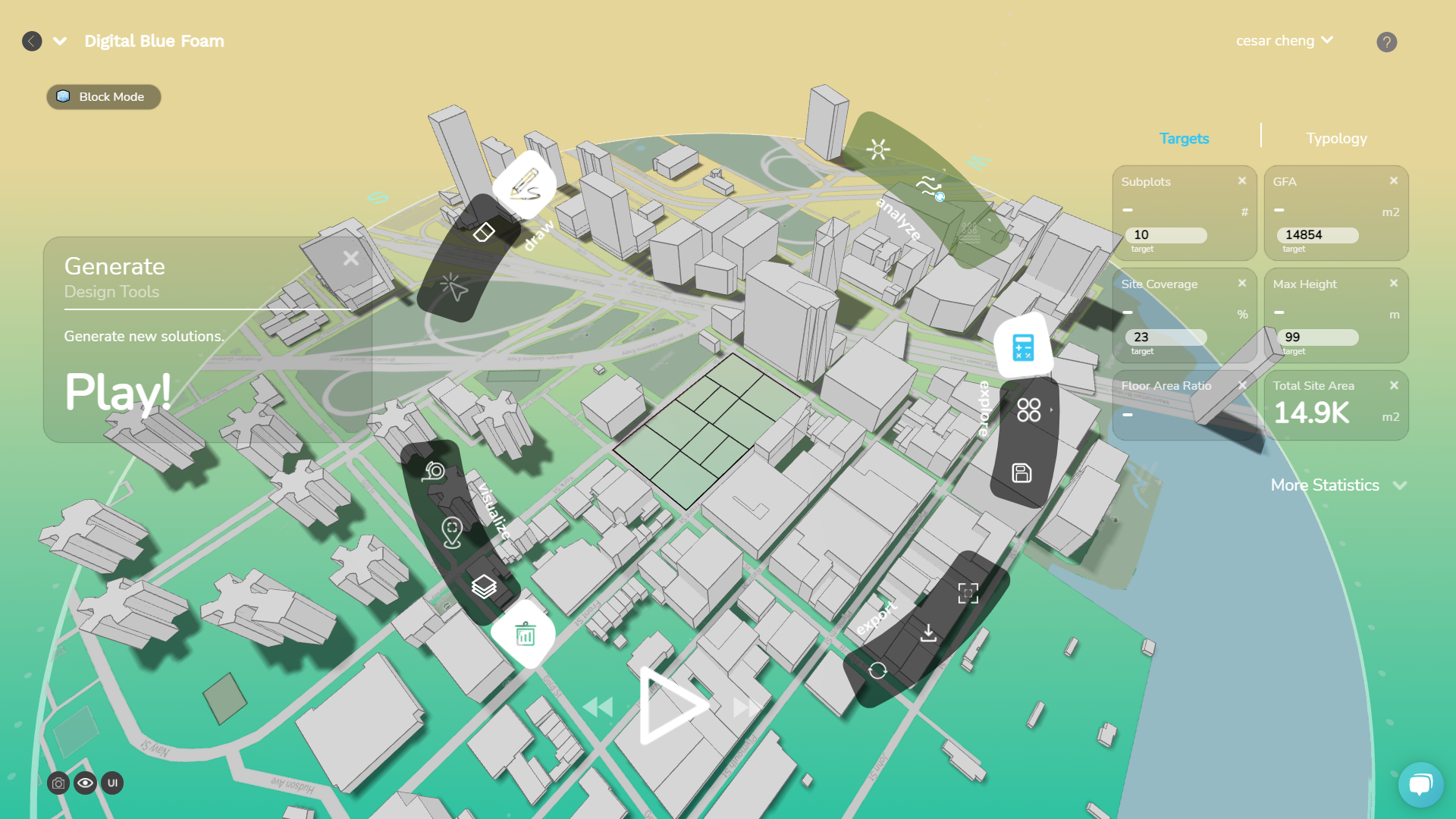
Zoom In / Zoom Out : Mouse-Wheel
Use the scroll wheel of your mouse in order to zoom in and out.
Pan View : Right click + Hold
Right click + Hold in order to pan around the 3d environment.
Orbit View : Left click + Hold
Left click + Hold in order to orbit around the 3d environment.
Ribbon Menu
In the ribbon menu you will find the different tools that Digital Blue Foam offers to help you sketch, explore, generate, visualize and export design options.
4. Draw
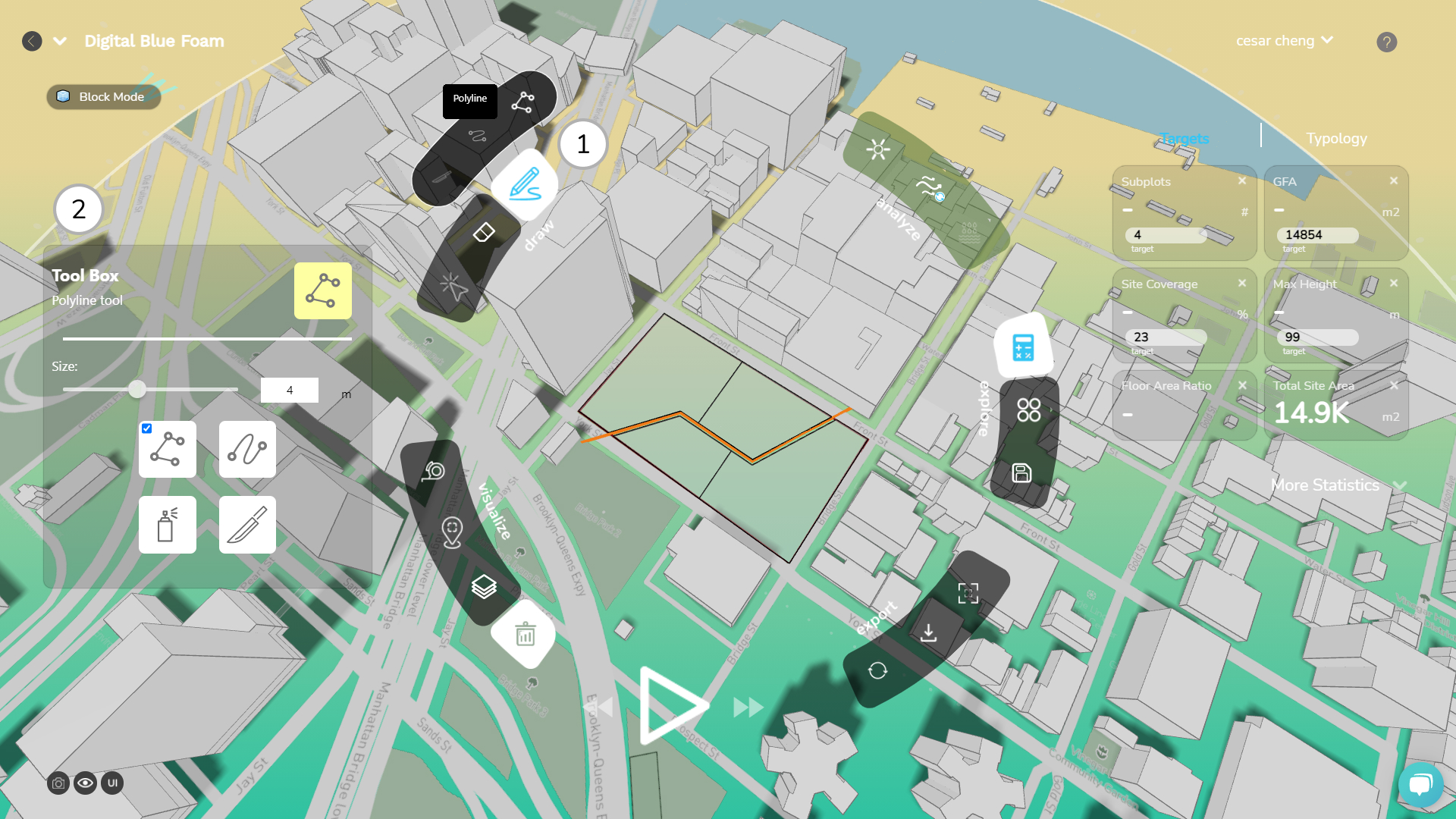
The Drawing tools allow you to sketch your ideas quickly and generate buildings. Using the drawing tools you are able to test different design scenarios, building configurations and divisions of a site. With a few strokes you can subdivide your site and click on the play button to generate design solutions using your AI assistant.
1. Polyline tool
Activate the Polyline by clicking on the polyline button. To draw a polyline:
- Pick the start of the first segment.
- Pick the end of the first segment.
- Continue picking points to draw more segments
- Continue picking until the polyline is complete, and double click to finish.
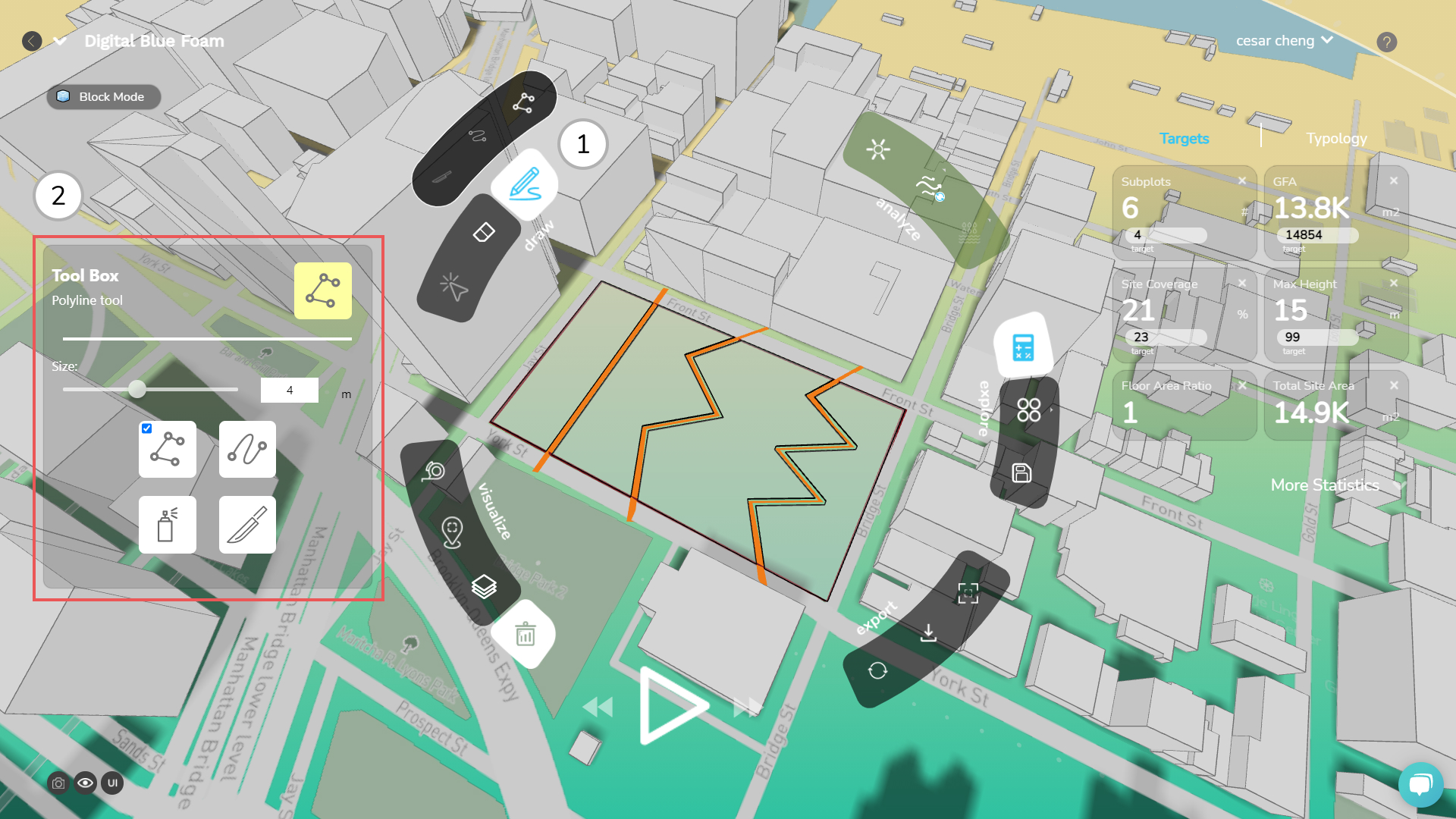
2. Drawing Tool-box
On the left side panel you can find the drawing tool box. These are different design tools you can use to sketch out and give shape to your ideas.
3. Eraser tool
Activate the Eraser to delete any pencil stroke or polyline.
- Right Click + Hold over the strokes previously drawn.
- Make sure to pass the eraser over the stroke you want to delete.
- Your site should be clear of the strokes you selected to erase
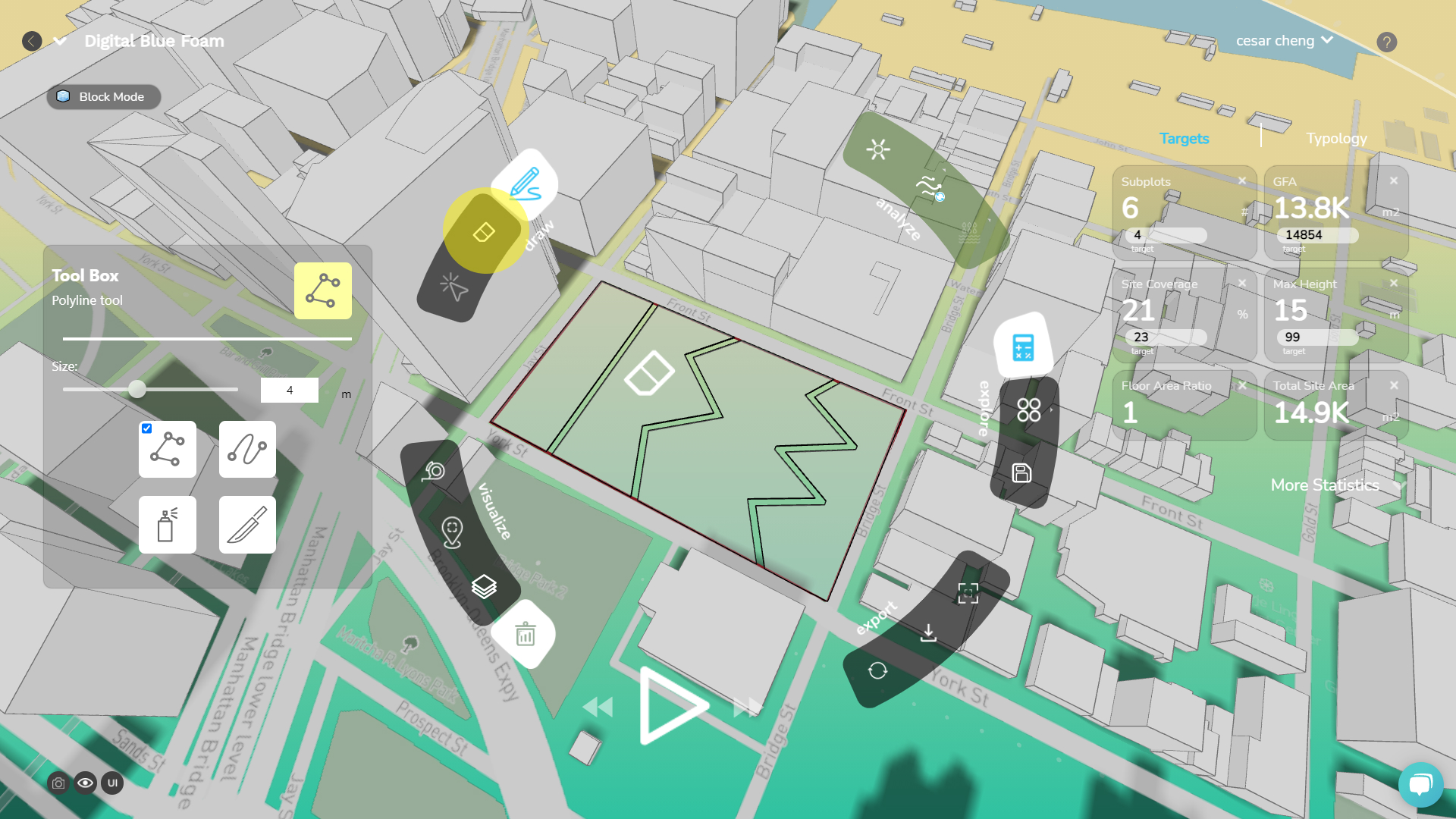
4. Clear design space
To clear your site from any strokes or blocks, click on the Clear design icon (trash bin) on bottom left of the ribbon menu. This will remove all elements that you have drawn and leave you with a clean slate to start over.
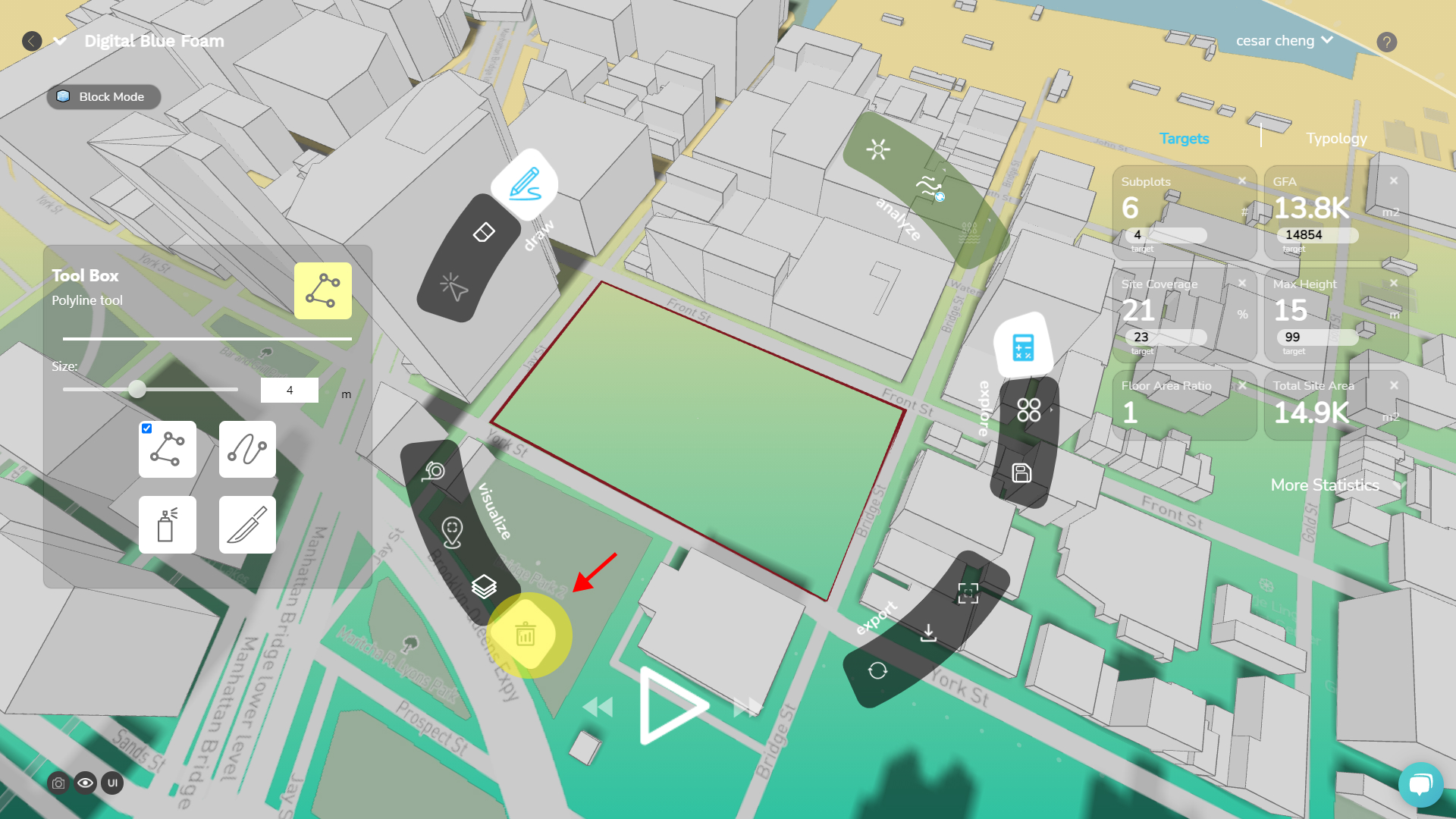
5. Generate
The generate tool will help you explore design solutions for your site. We will explain how to use the generate tool in 3 simple steps:

1. Set Goals and Constraints
You can start by setting goals and constraints for your project on the right hand-side settings panel. In this panel, you can define the following input parameters: Number of Subplots, Site Coverage, Gross Floor Area and Maximum Height.
Additionally, you can click on the Typology tab of the settings panel, to further customize your settings. On the top part of the menu you can define what building typologies you would like to use. On the bottom part of the menu you can define other parameters such as, building offset, building cantilever, grid resolution and plot angle(orientation).
These inputs will be used to inform your design exploration and test out possible design solutions for your site.
2. Draw Subdivision lines
You can start from an empty site, the generate will use the number of subplots you specified in the
You can use the divisions lines that you created with the Drawing tools in the previous step. This will serve as guidelines for your design exploration.
3. Play Button
Click on the PLAY button to start generating design solutions for your site. The generate tool will use the settings that you specified in previous steps and present you with possible solutions.
Click on the PAUSE button to stop the cycling of options at any particular design that you find interesting.
Use FORWARD and BACKWARD buttons to go back and forth the options that have been generated.
In the example below:
- Goals and constraints are set.
- Site is divided into 6 subplots using the polyline tool.
- Generate tools is triggered by clicking on PLAY button.
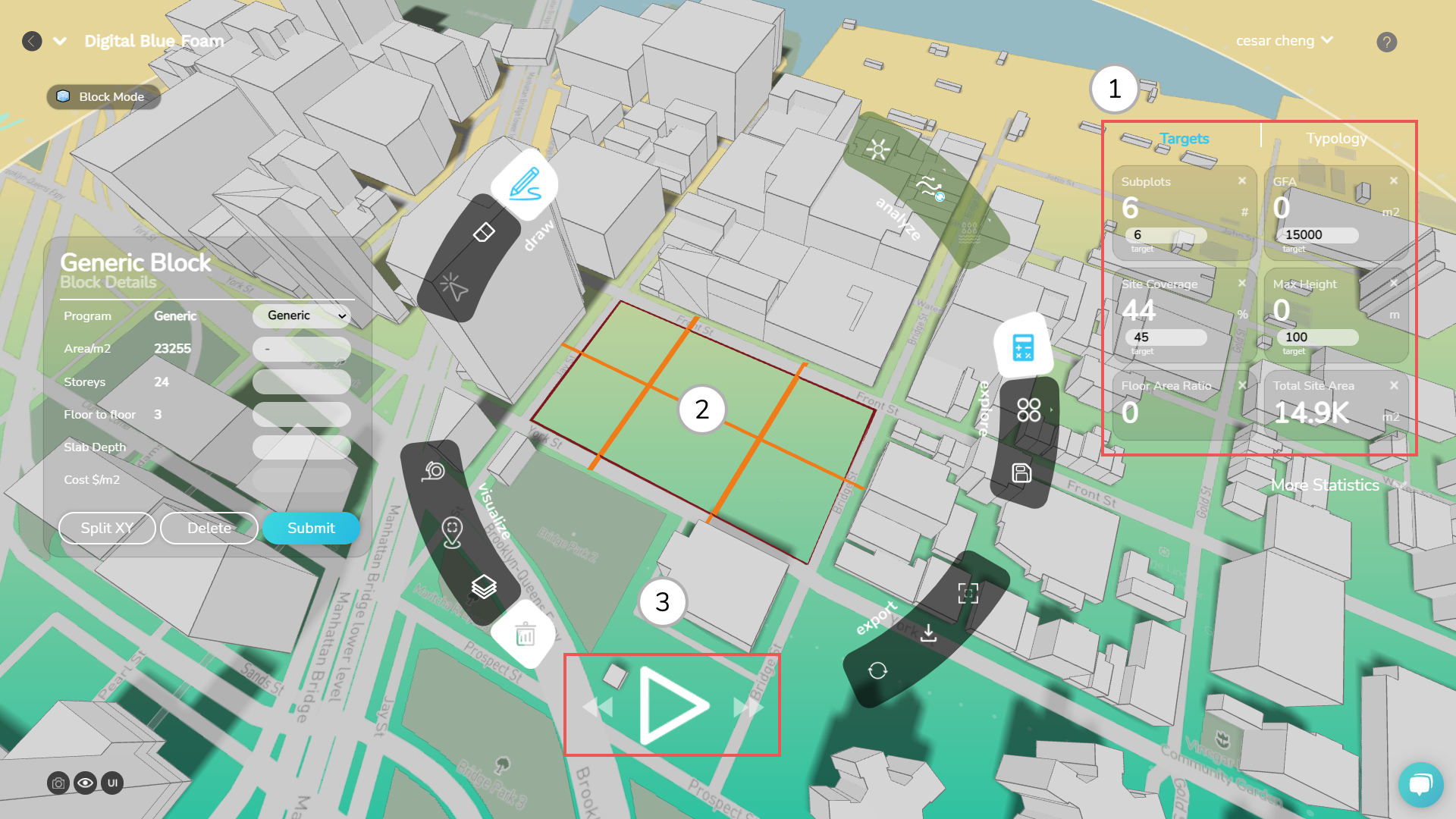

6. Modify
You can modify design options by clicking on a specific block or plot.
- Hover over a block or plot and click on it to select it.
- On the left side you will find the modification panel with information on the item selected.
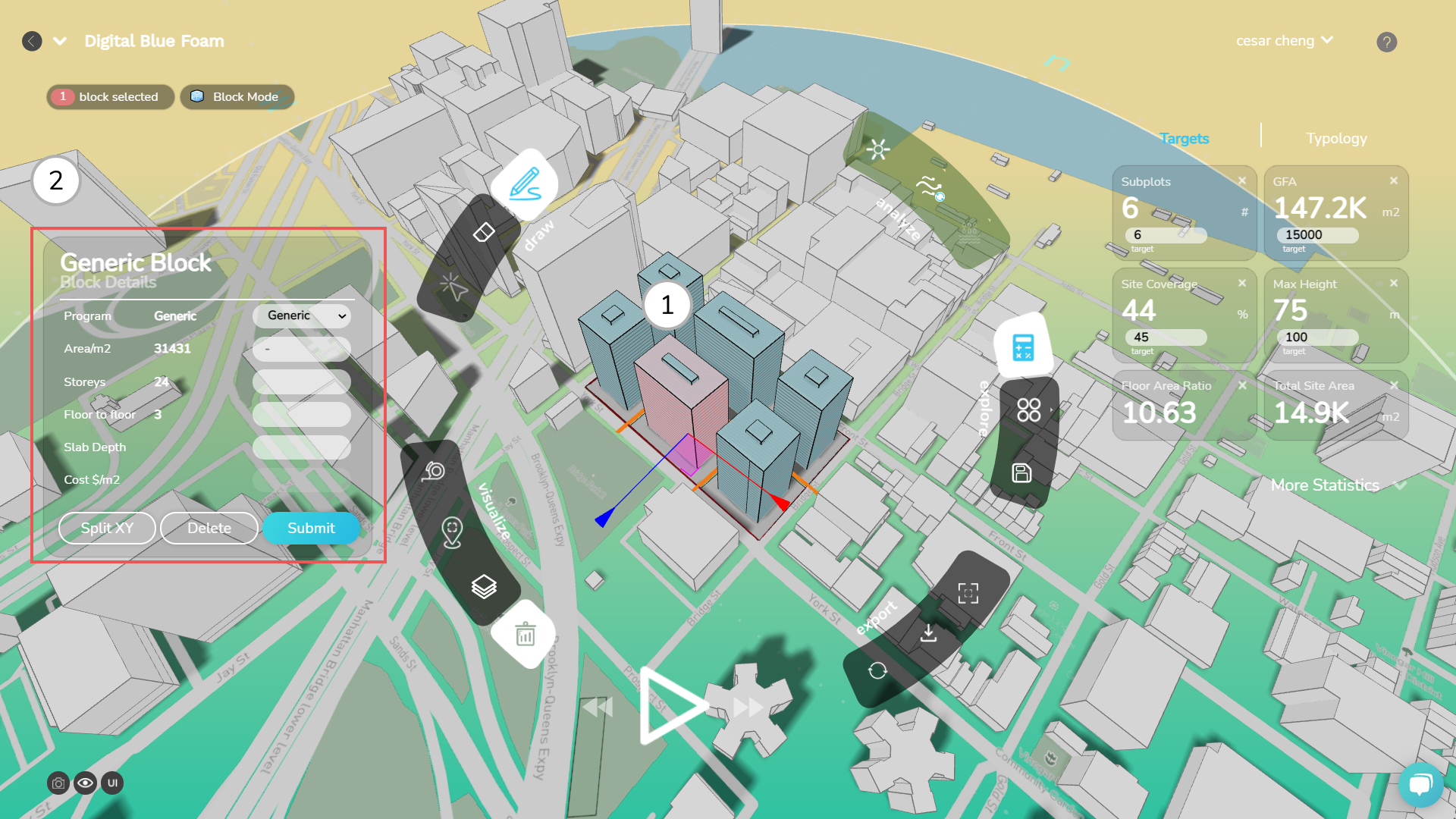
Modify Panel
In the modify panel, you will find the following information about the selected object:
- Change Program
- Add Stories
- Change Floor to Floor Height
- Change Slab Depth
Assign Program
- Click on the program dropdown menu and select from the list another program.
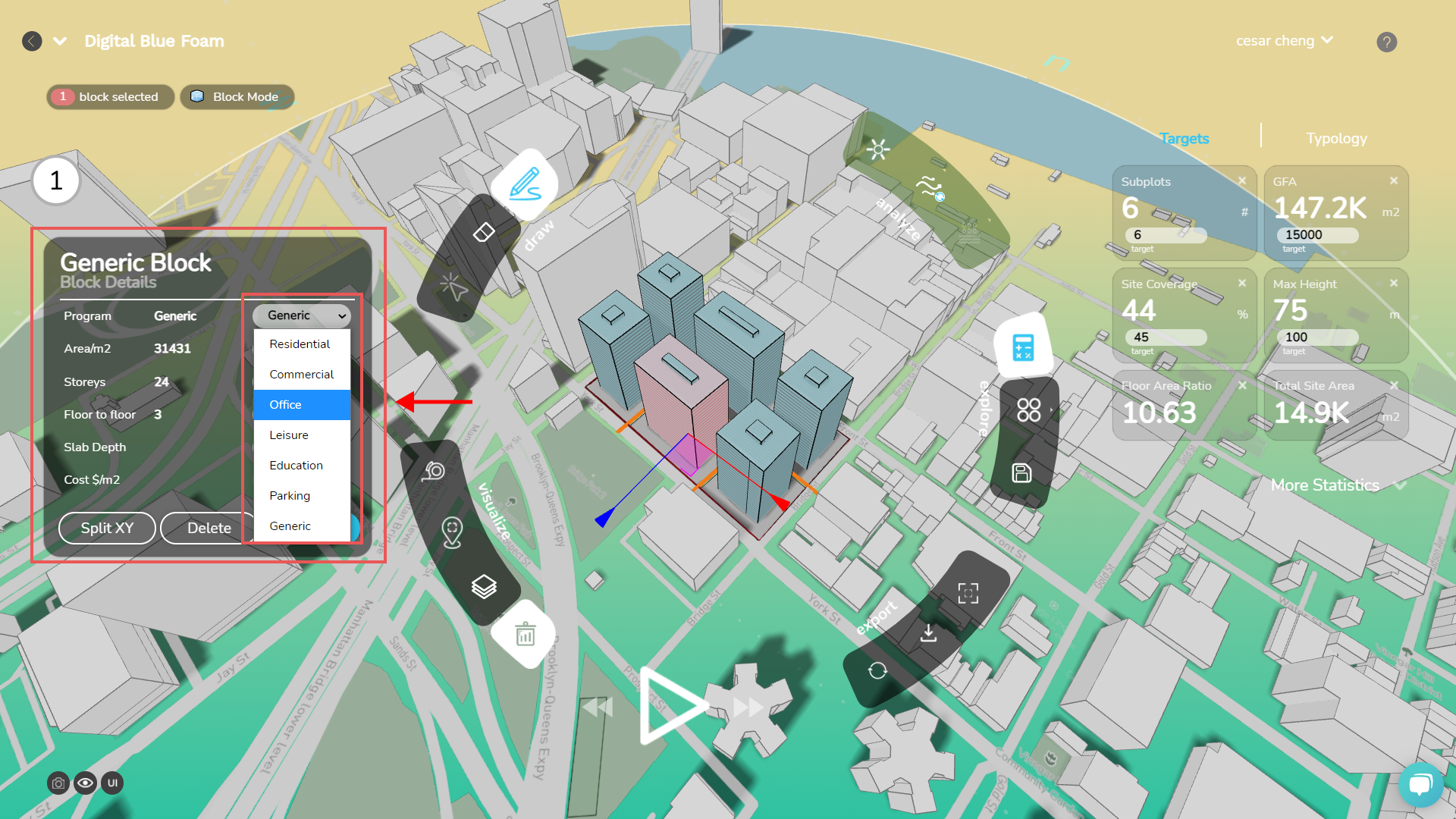
- Click on the Submit button to modify.

Change Number of Stories
Input the nubmer of levels in the field. E.g. 5 stories
Click on the Submit button to modify.
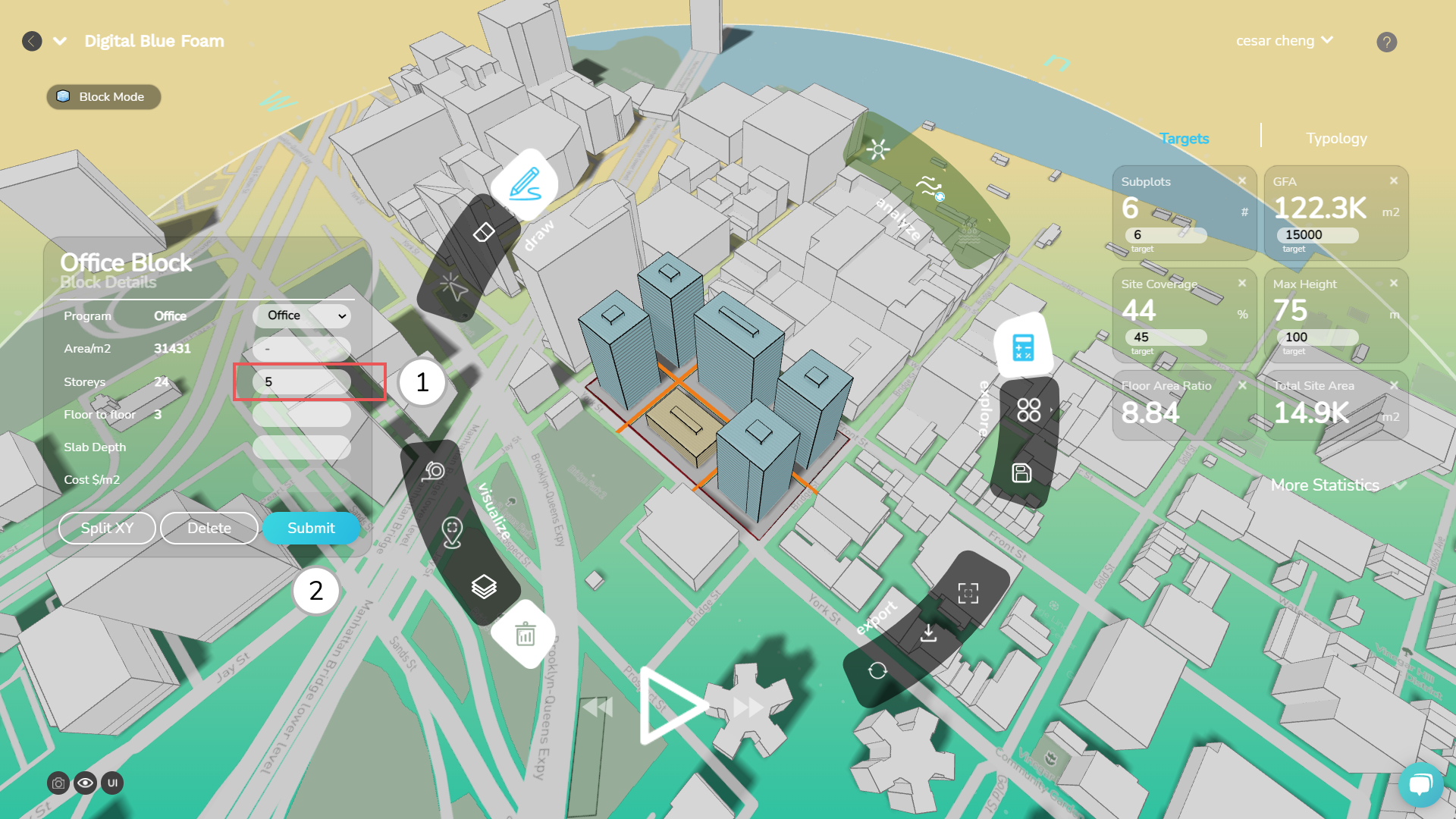
In the image below you can see a resulting design after assigning different programs to all 6 buildings and changing their heights.
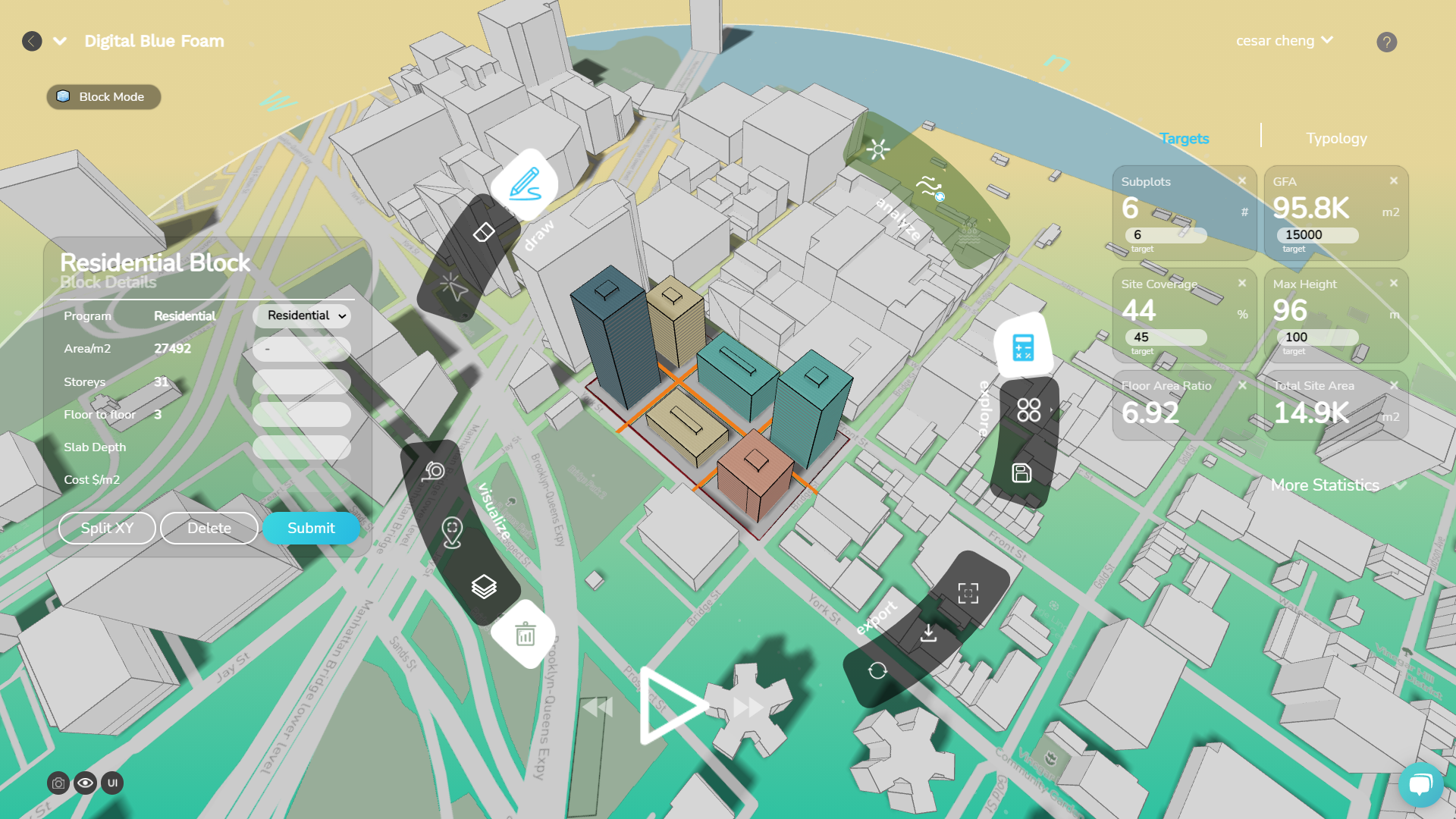
7. Edit Mode
Transformations: Move, Scale and Rotate
In order to move, scale and rotate blocks, you can use the gumball commands. The Gumball displays a gumball widget on a selected object facilitating move, scale, and rotate transformations around the gumball origin.
By default when you select a block the gumball mode is set to Move. You can activate the other gumball modes with the keyboard keys [W] move, [E] Rotate and [R] Scale.


Edit Mode
You can modify your design blocks by pushing and pulling the block faces. This would allow you to have greater control over your massing study, align building faces, create setbacks, and shape more complex building configurations.

Create Building Setbacks
Combine Split Block modificaton with Push and Pull edit mode transformatons to create setbacks in your design. The image below shows a sequence of operations to create a multi-tier tower with setbacks at different levels.

In the image below you find resulting design after combining block edit and push/pull modifications.
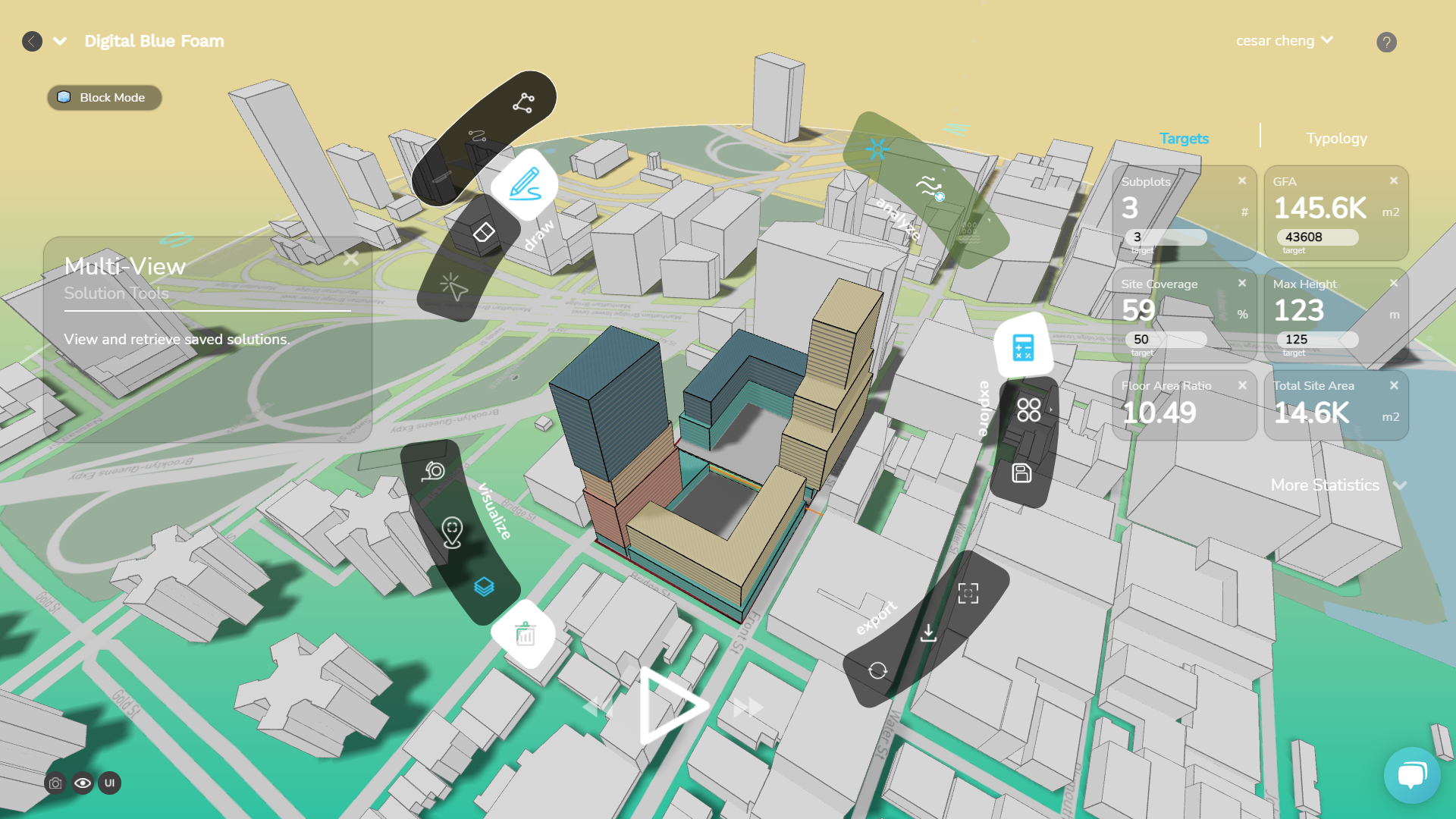
8. Analyze
DBF Sustainability analysis allows you to generate quick solar and wind studies and download repots with key information about your project. In the top right side of the ribbon menu you can find the sustainability analysis tools. Click on the buttons to activate Sun Studies and Wind Studies analysis options.
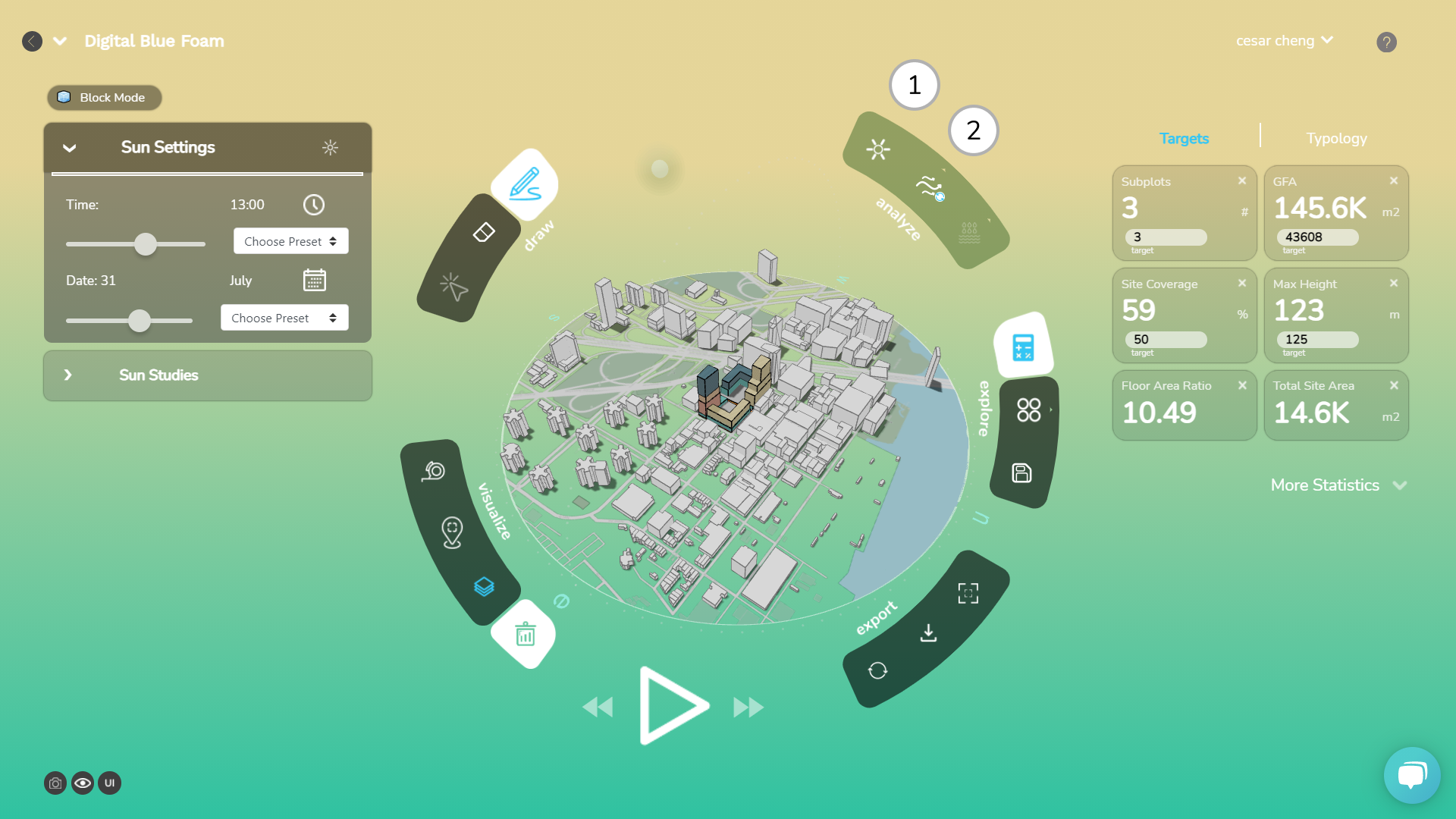
Sun Settings
- Activate the Sun Studies by clicking on the sun icon.
- Control the sun position by selecting a particular date and time of the year. The dropdown menu allows you to quickly select useful times and dates for your sun study.
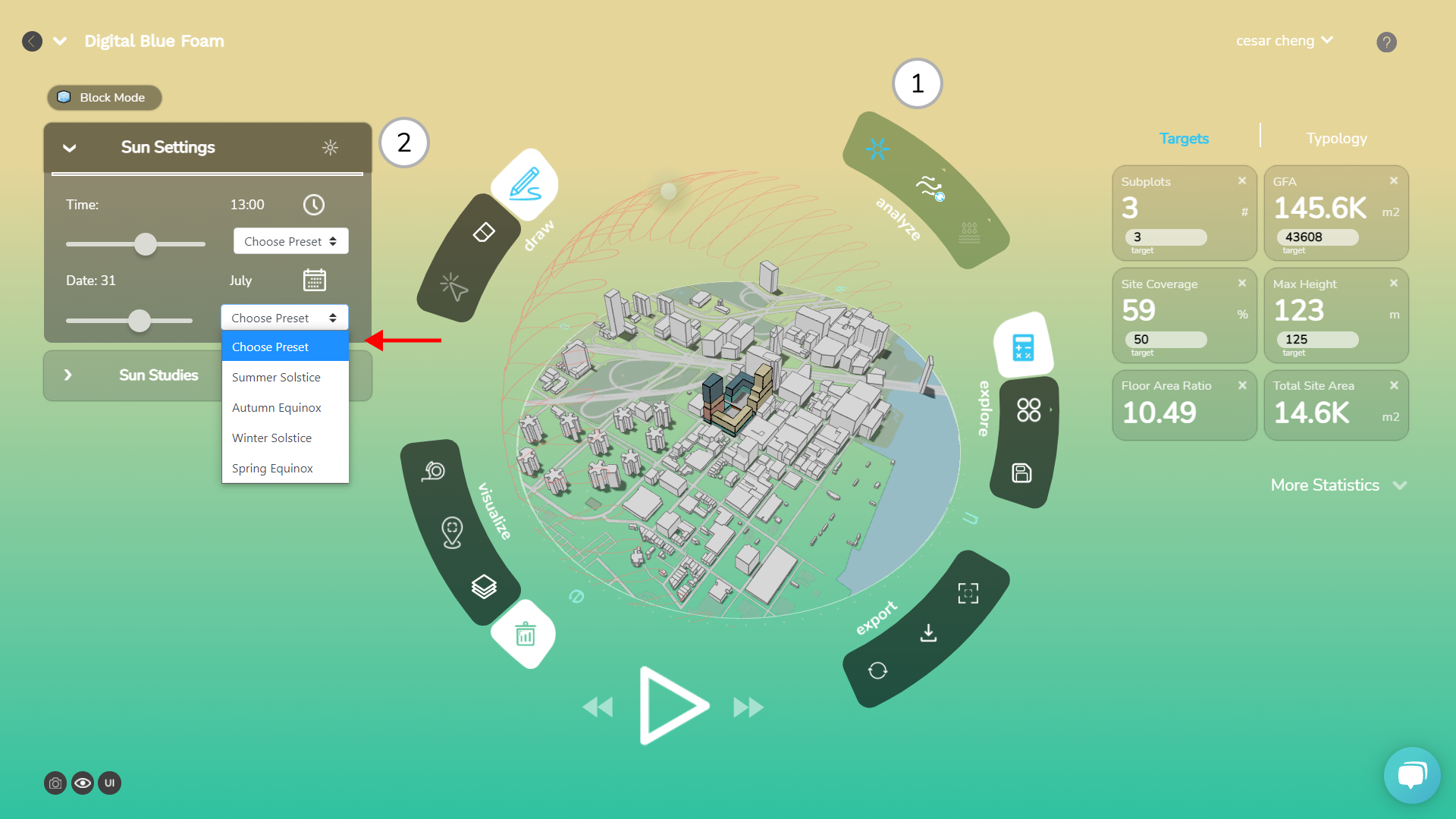
Sun Studies
DBF Sun studies allows to perform shadow, sun hours and daylight autonomy analysis for your project.
- Click on Sun Studies icon and open the Sun Studies panel.
- Choose the Sun study you would like to perform. E.g. Sun Hours
- Select the Season(time of the year) you would like to perform sun hour calculation.
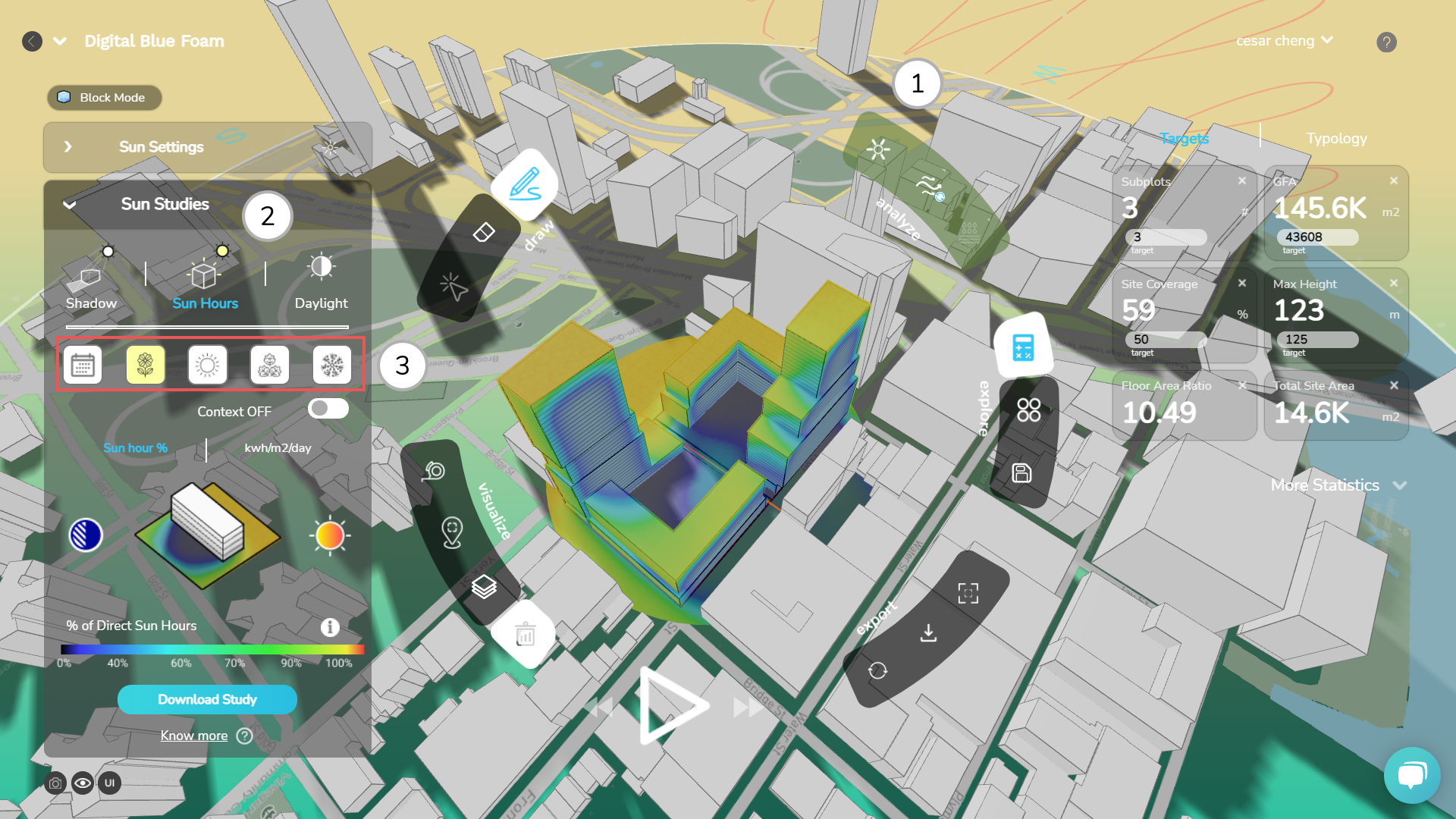
You can find more information about all sun studies in the Features section on this topic.
Wind Rose Diagram
DBF Wind studies allows to visualize the wind direction and prevalence in the location of your project.
- Open the Wind Studies panel by clicking on the wind icon in the ribbon menu.
- Activate the Wind-Rose diagram
- Toggle between seasons by clicking on the sub-menu season icons.
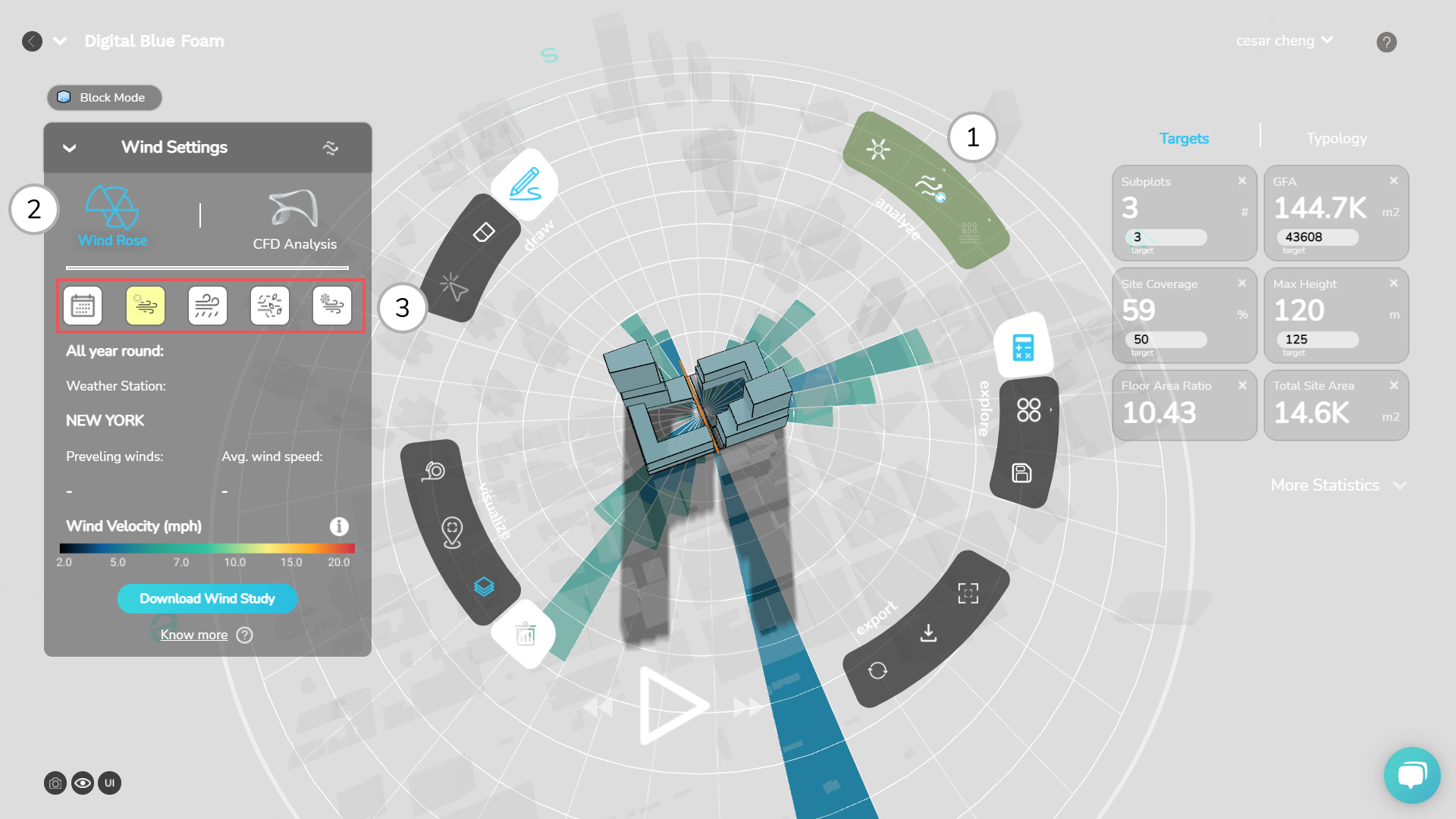
You can find more information about all sun studies in the Features section on this topic.
9. Save Design Solutions
Once you have arrived at a design solution that you like, you can save this design option so you can compare and export your desing option later on.
On the right hand-side of the ribbon menu you will find two buttons:
1. View Solutions (four circles icon): Click on the View solutions icon to toggle between your saved solutions.
2. Save solutions (save disk icon): Click on the Save solutions icon to save the current design option on display. Alternatively you can click on the + icon in the saved solutions submenu. The + icon indicates that you have a lot available to save a solution.
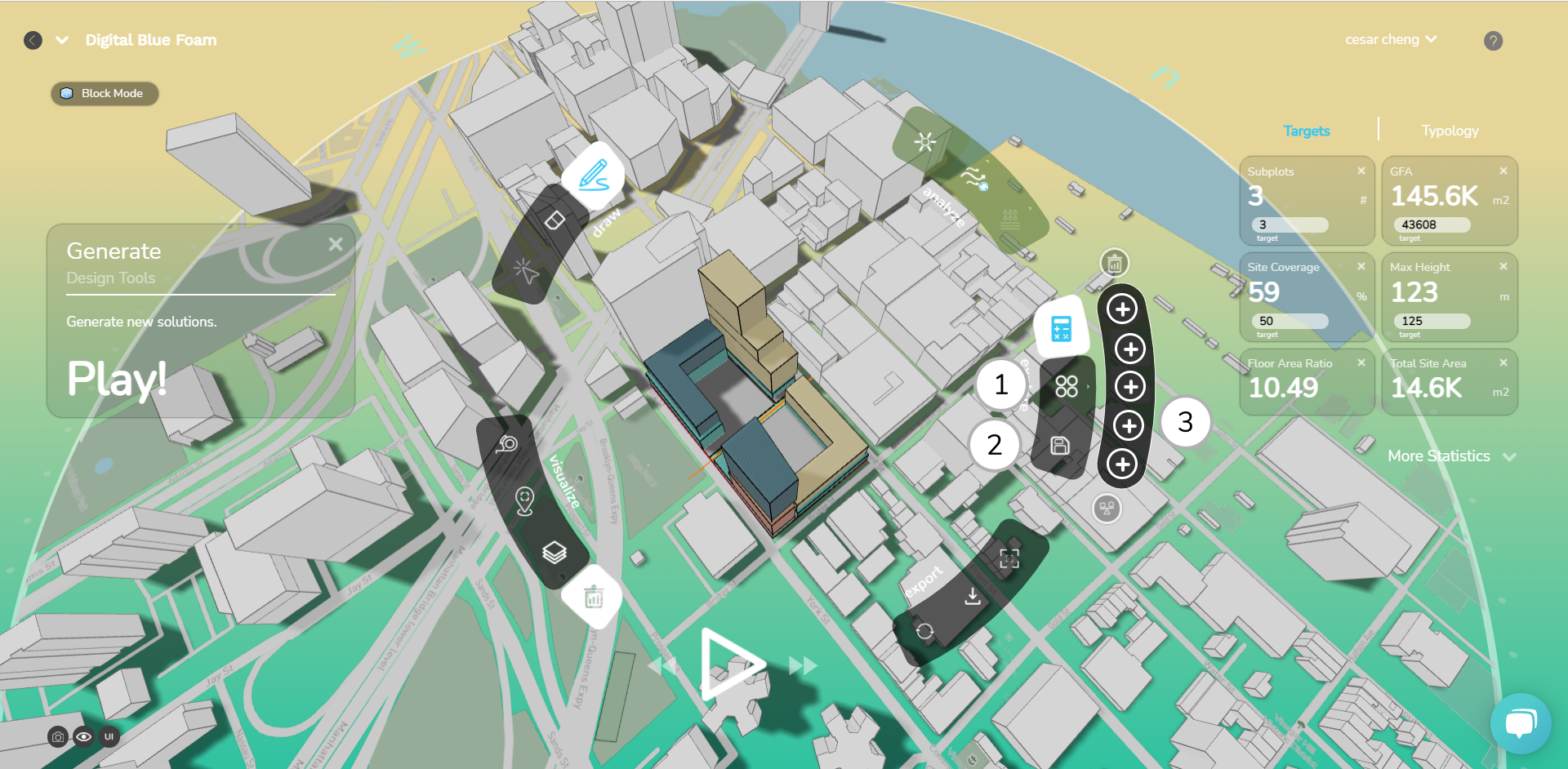
3. Saved solution: The solution slots get populated with your saved solutions. Toggle between your saved solutions by clicking on saved solutions options.

4. Delete a Solution: To delete a solution, click on the View Solutions icon. This will open up the submenu where you see your saved solutions in each of the circle slots. To delete a particular solution Click and Drag the solution to the Trash Bin icon located on the top of the submenu.
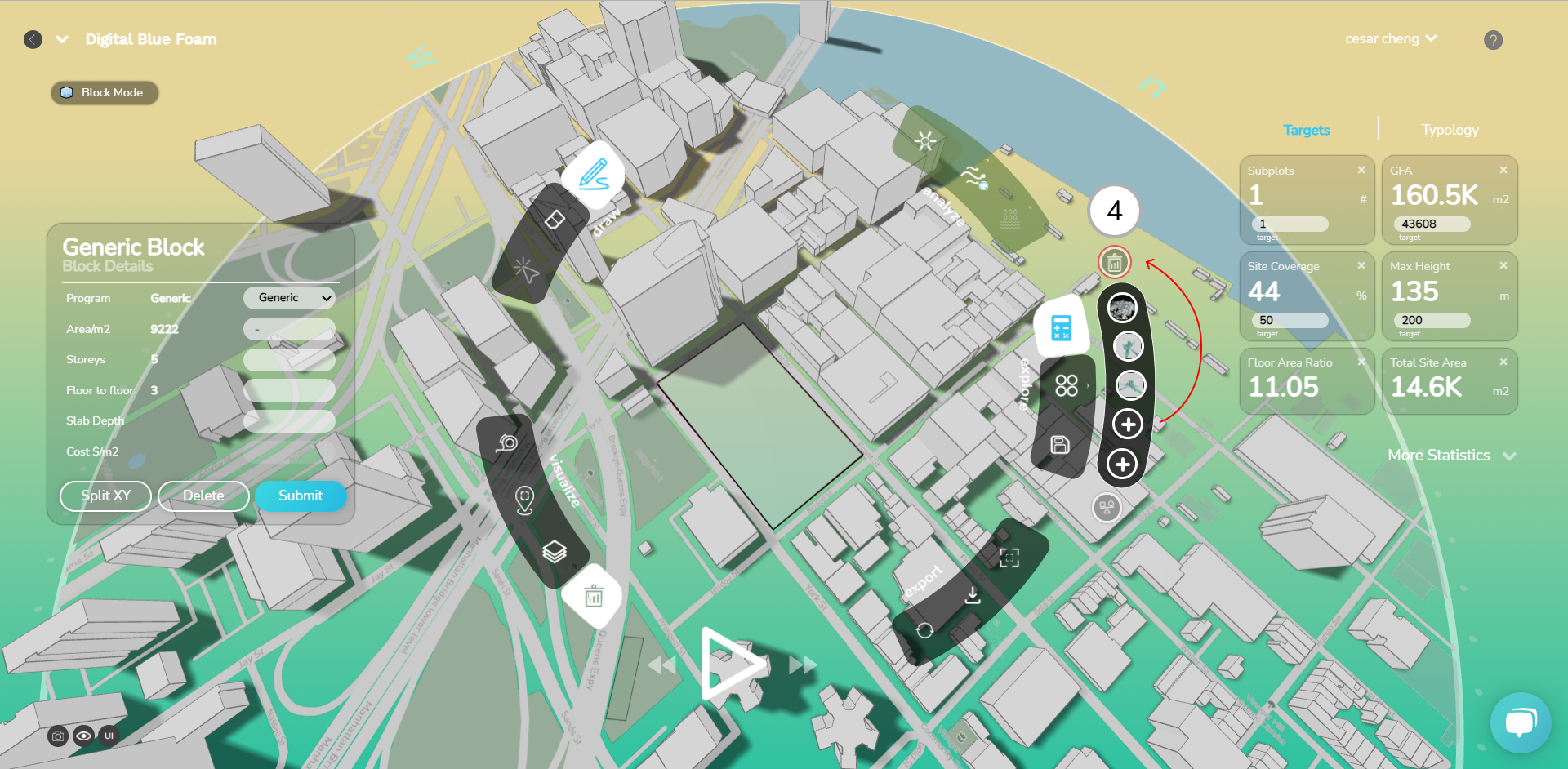
10. Compare Page
You can compare your design solutions in DBF Compare Page. Once you have saved your design solutions you can access the compare page and you will see a comparative matrix of your saved solutions. You can access the Compare Page directly from the project tool or from your dashboard.
- Once you are in a project you can click on View Solutions on the right side of the Ribbon Menu. At the bottom of the sub-menu you will find a Compare button (Balance icon), you can click on this button to open the Compare Page.
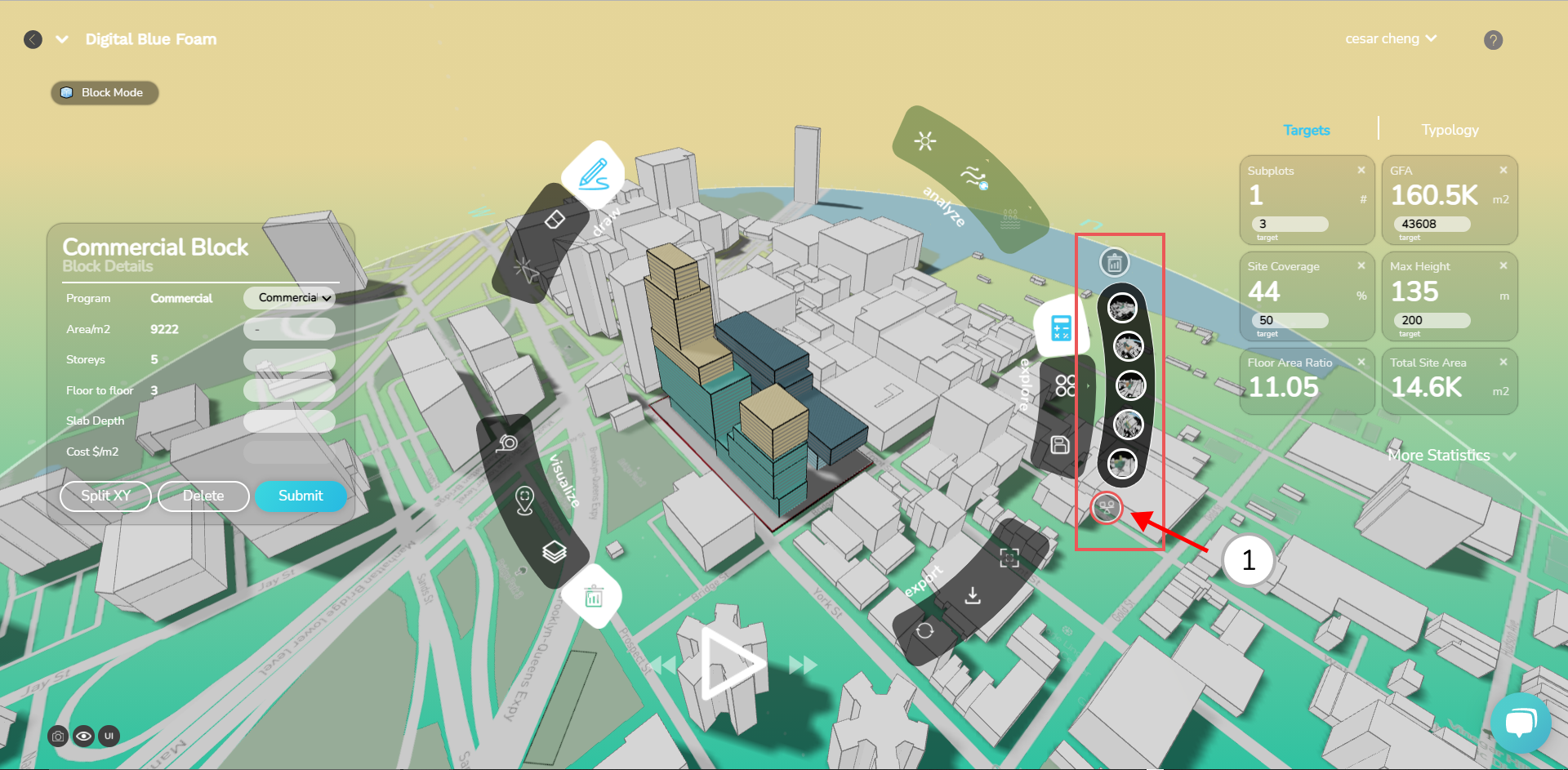
Compare Page
In the compare you will find a comparative matrix where you can compare your design solutions according to building key statistics and program breakdown.
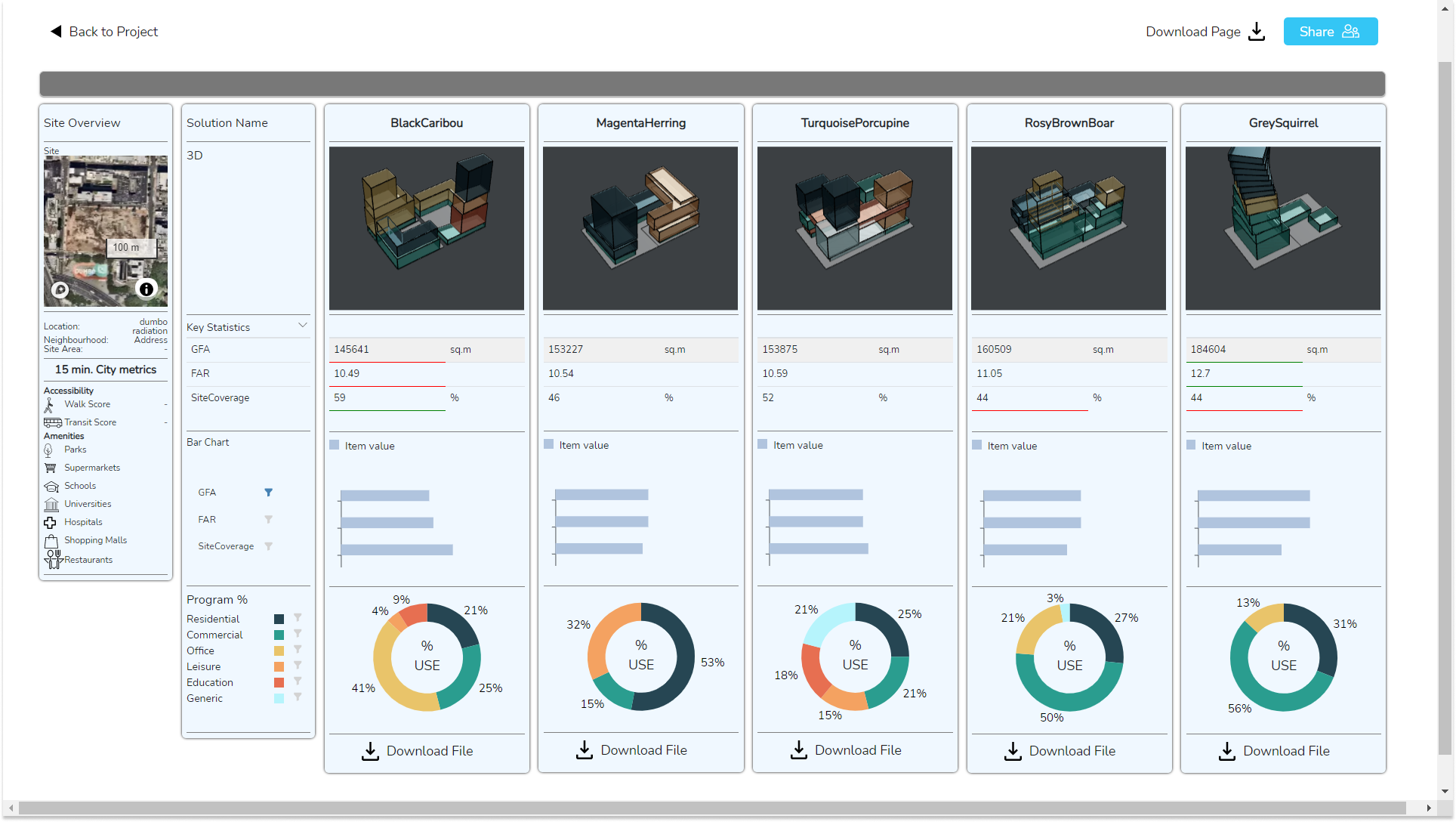
11. Export
You can export your design solution by clicking on the icons located at the bottom right side of the ribbon menu. The design solution on display will be exported or streamed to your BIM software of preference. If you would like to export a different solution make sure you select it from your saved solutions. Once the solution is on display you can click on any of the export options and the information of the option on display will be downloaded or Sync to BIM.
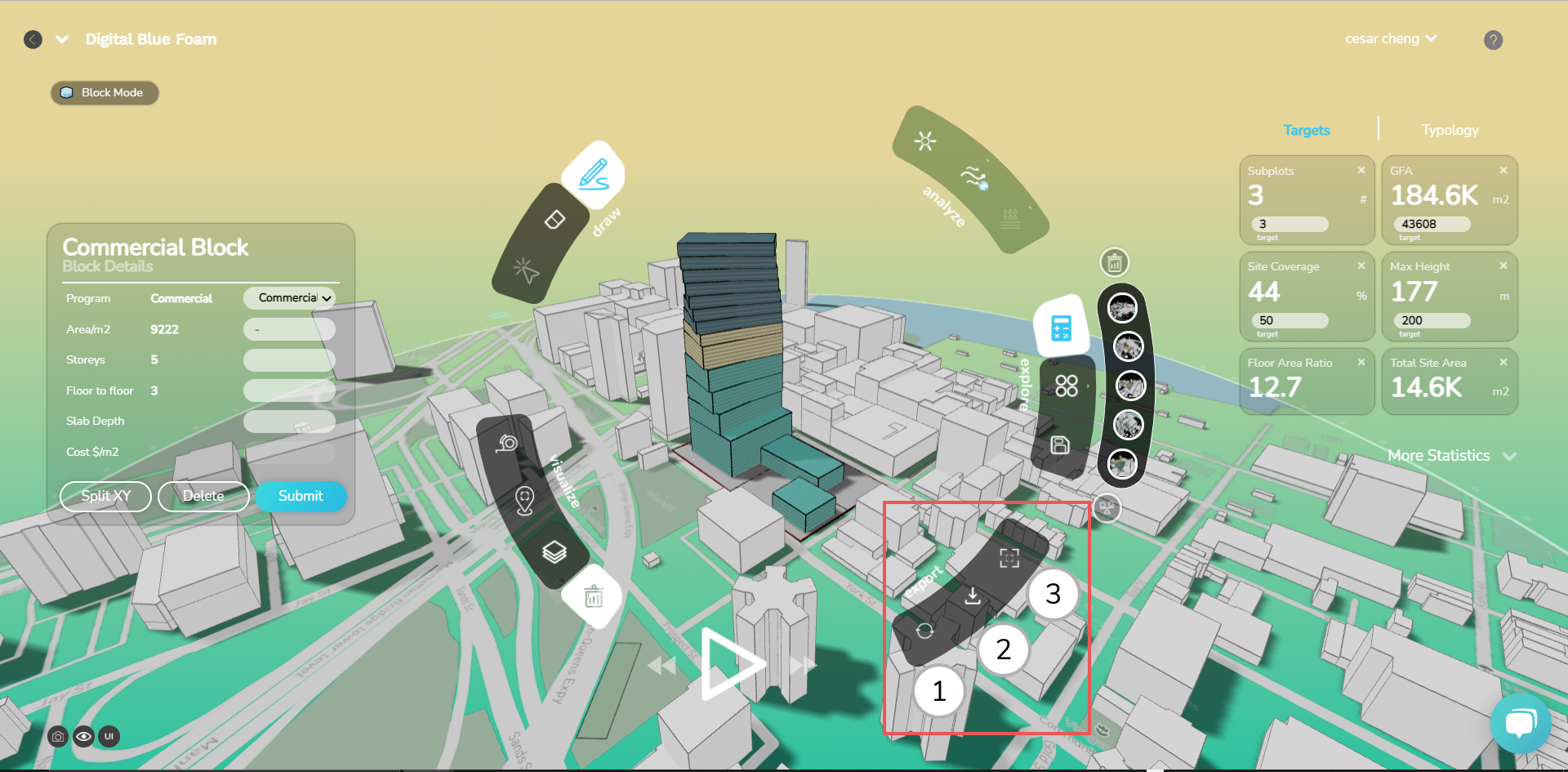
For each of you design solution you can:
- Sync to your BIM Software of peference for Revit and Arhicad
- Download 2D(.DFX), 3D(.STL) for Autocad and Sketchup
- Export Excel or CSV reports
Download
Click on download option and open the files on your desktop.
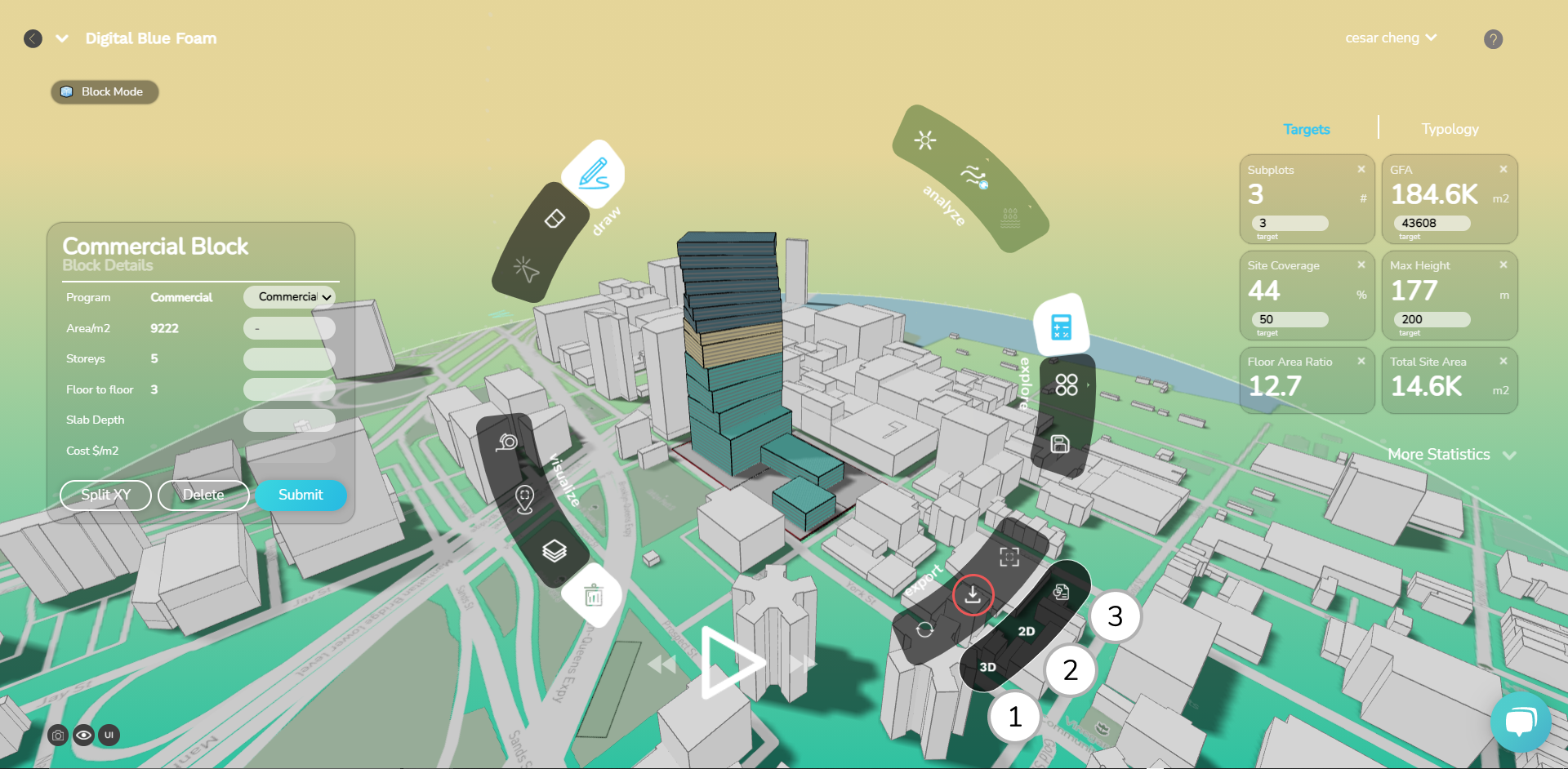
1. Sample of 2D(.dfx) export
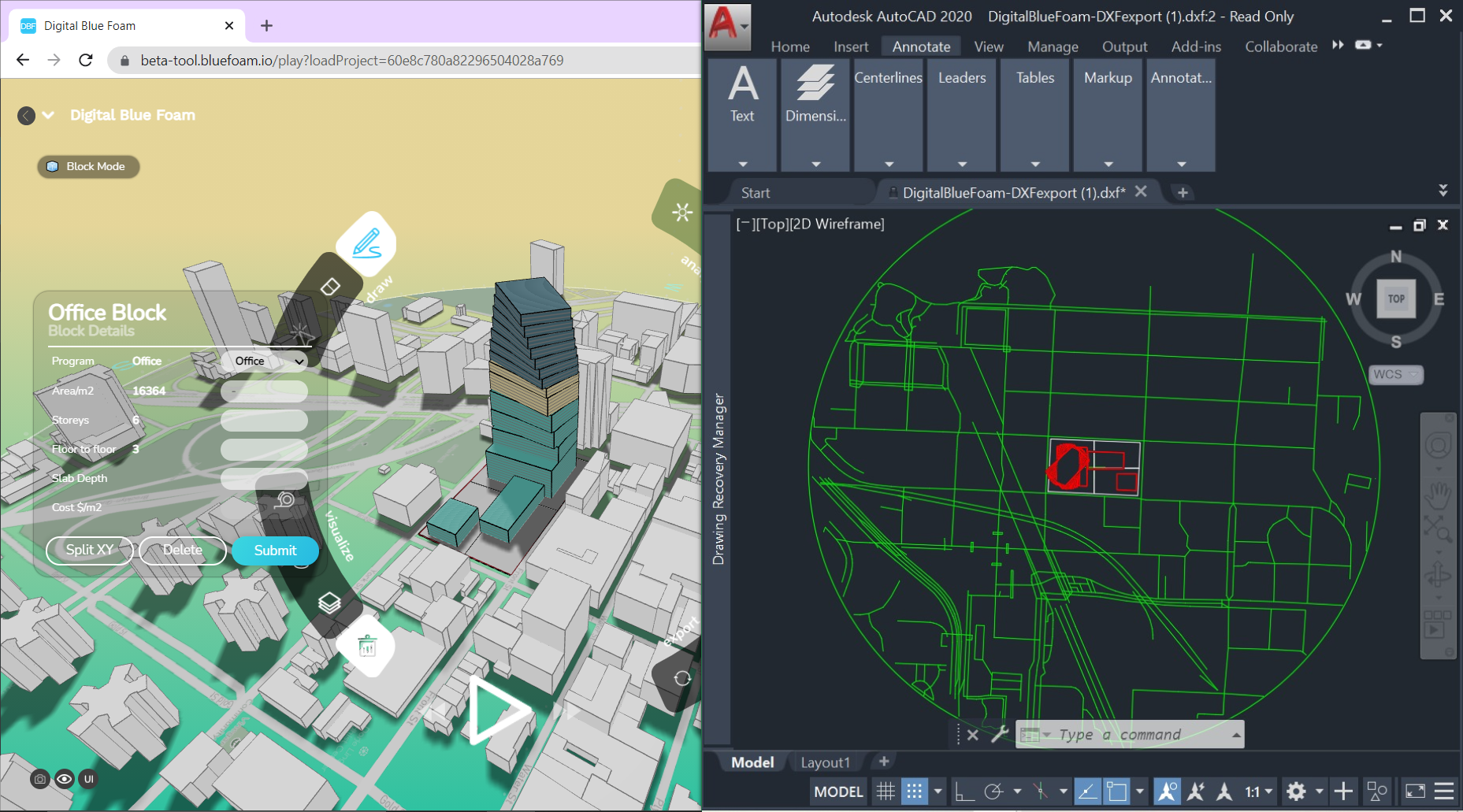
2. Sample of 3D(.STL) export
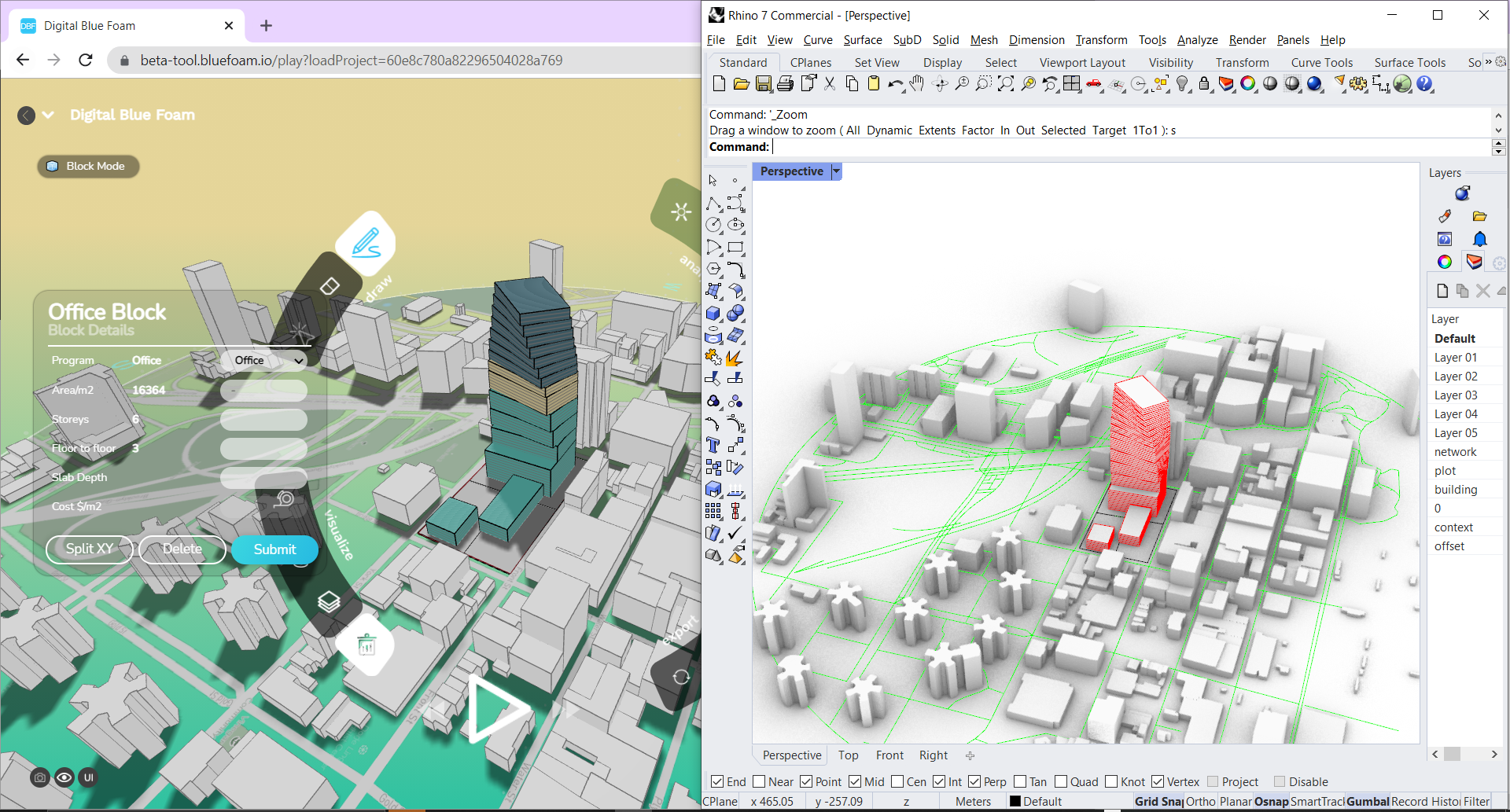
3. Sample of Excel Report
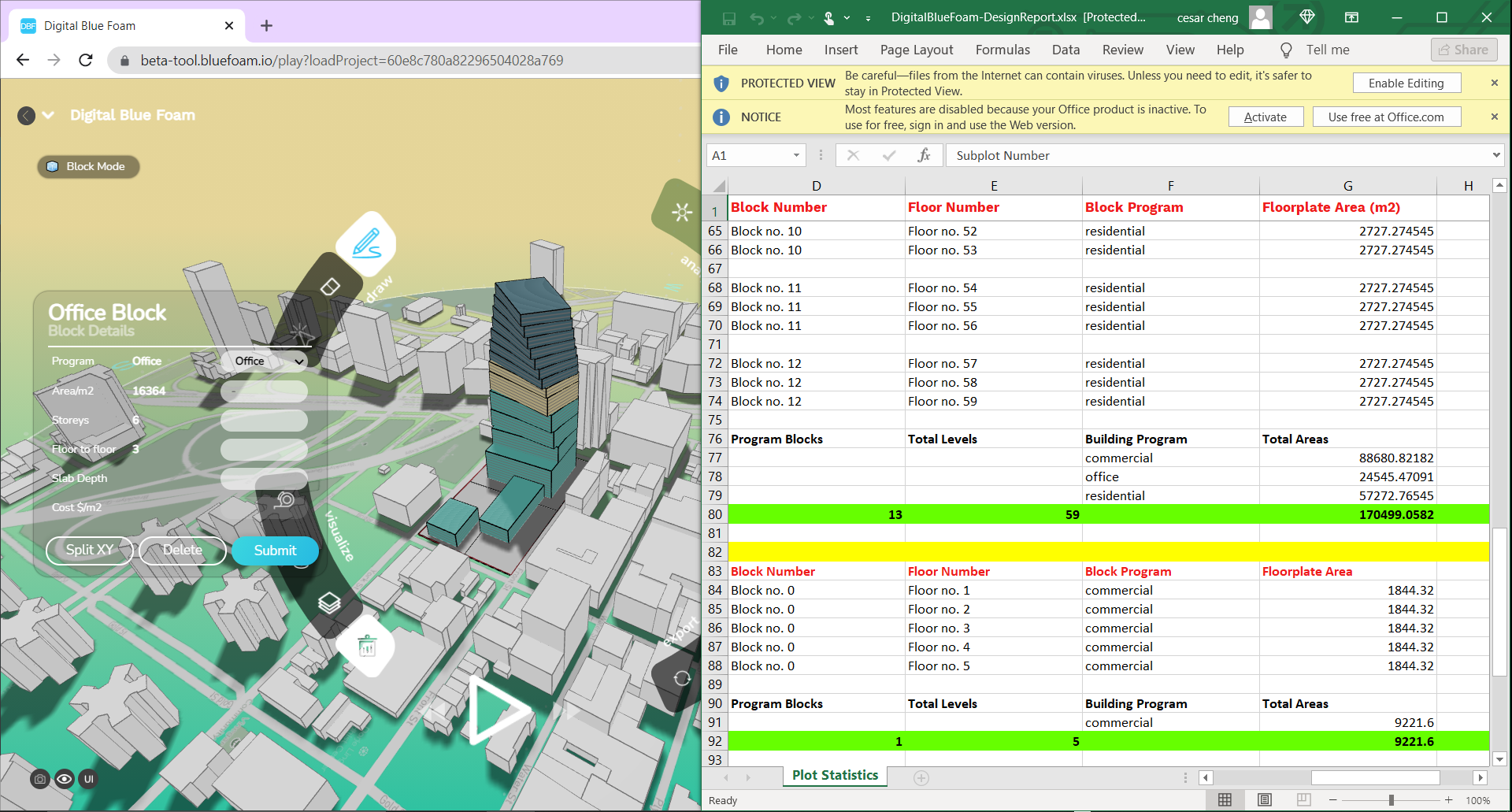
12. BIM Sync
Stream your model directly to Archicad or Revit using DBF Hub.
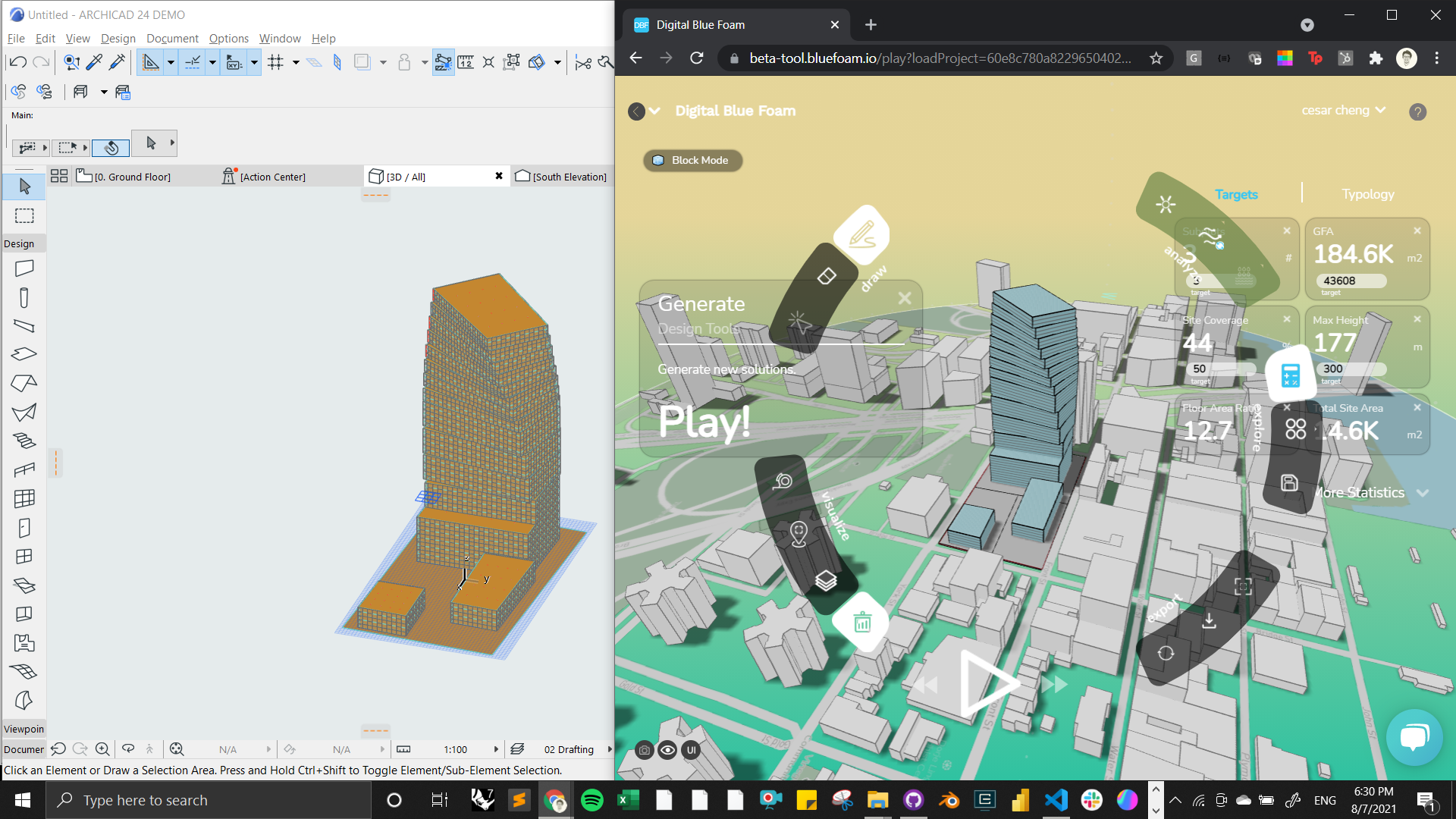
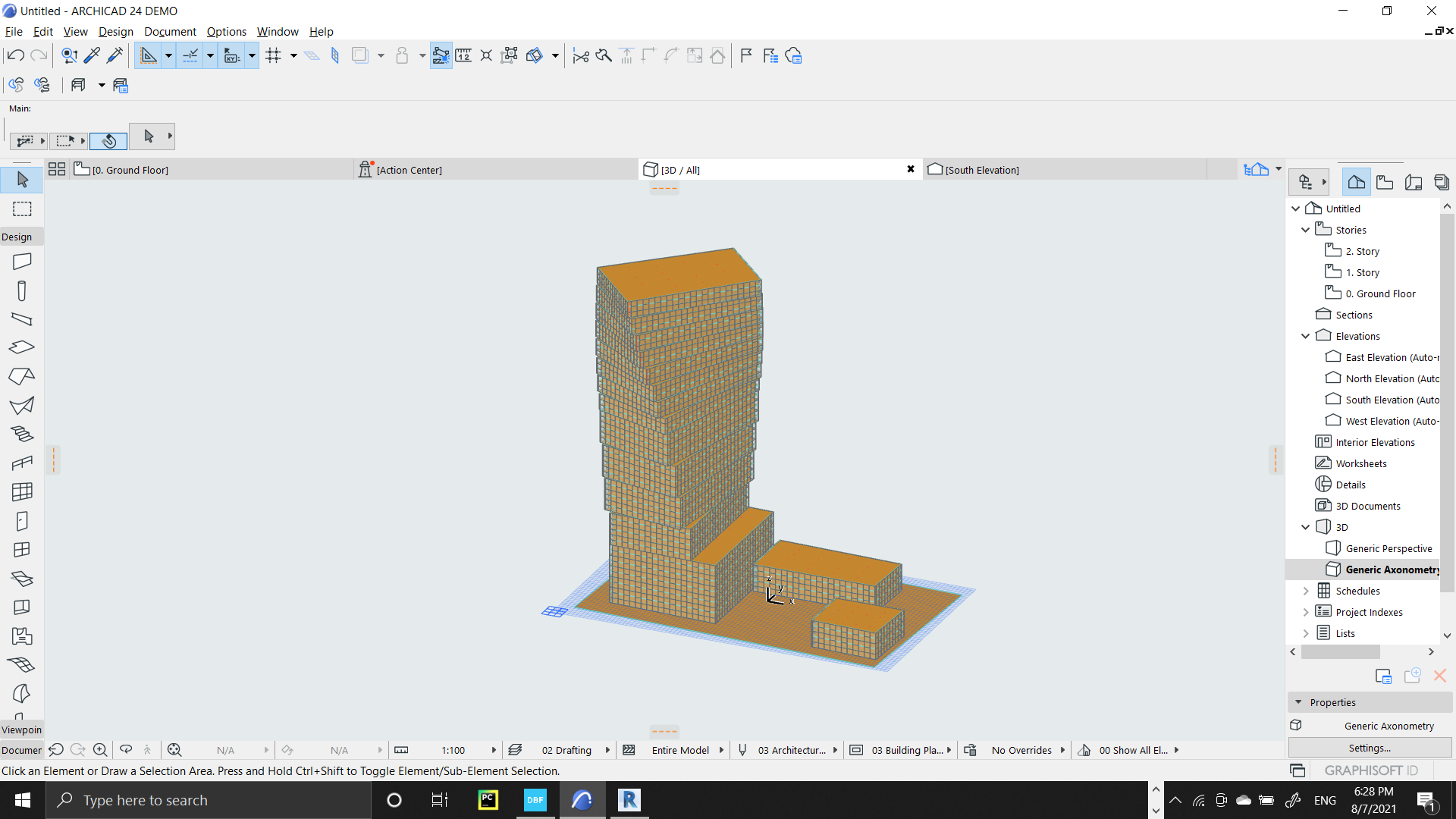
You can find more information about all sun studies in the DBF Hub section on this topic.